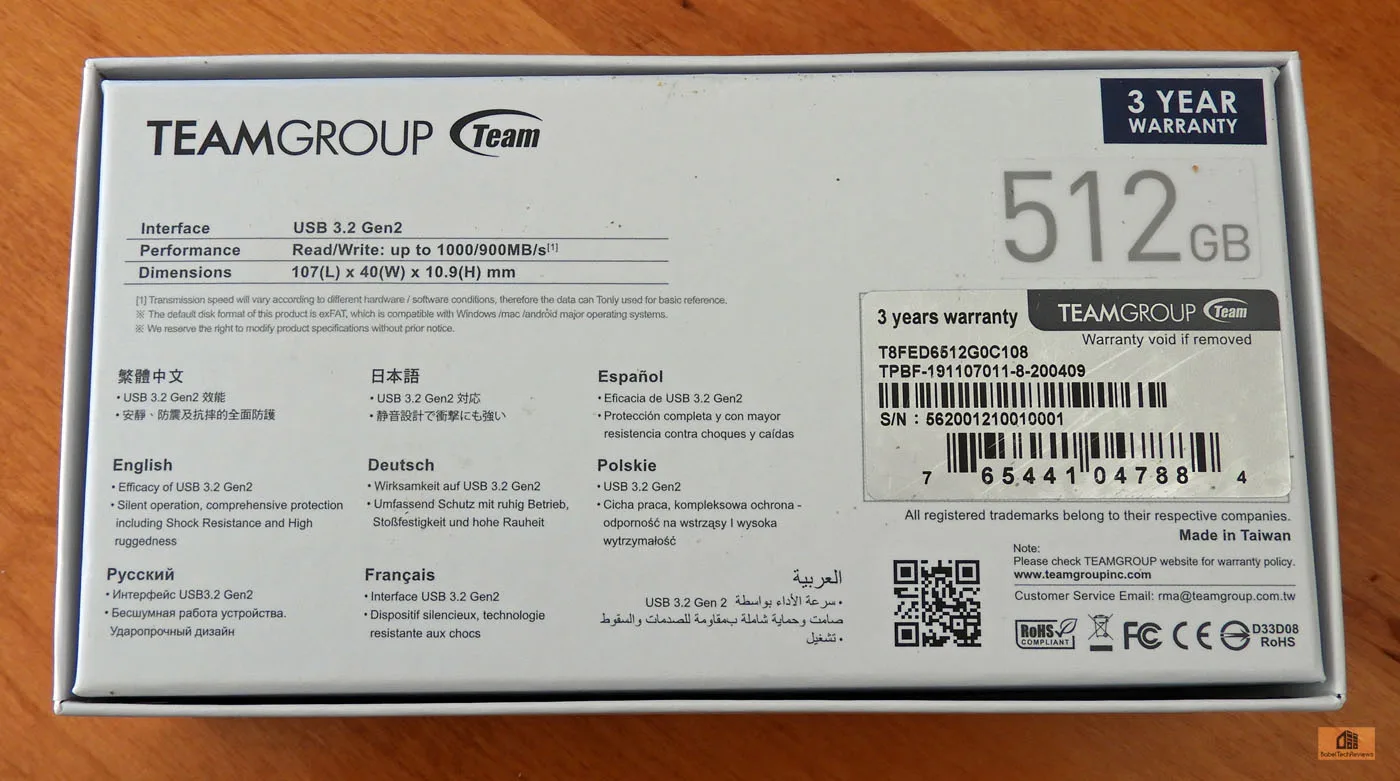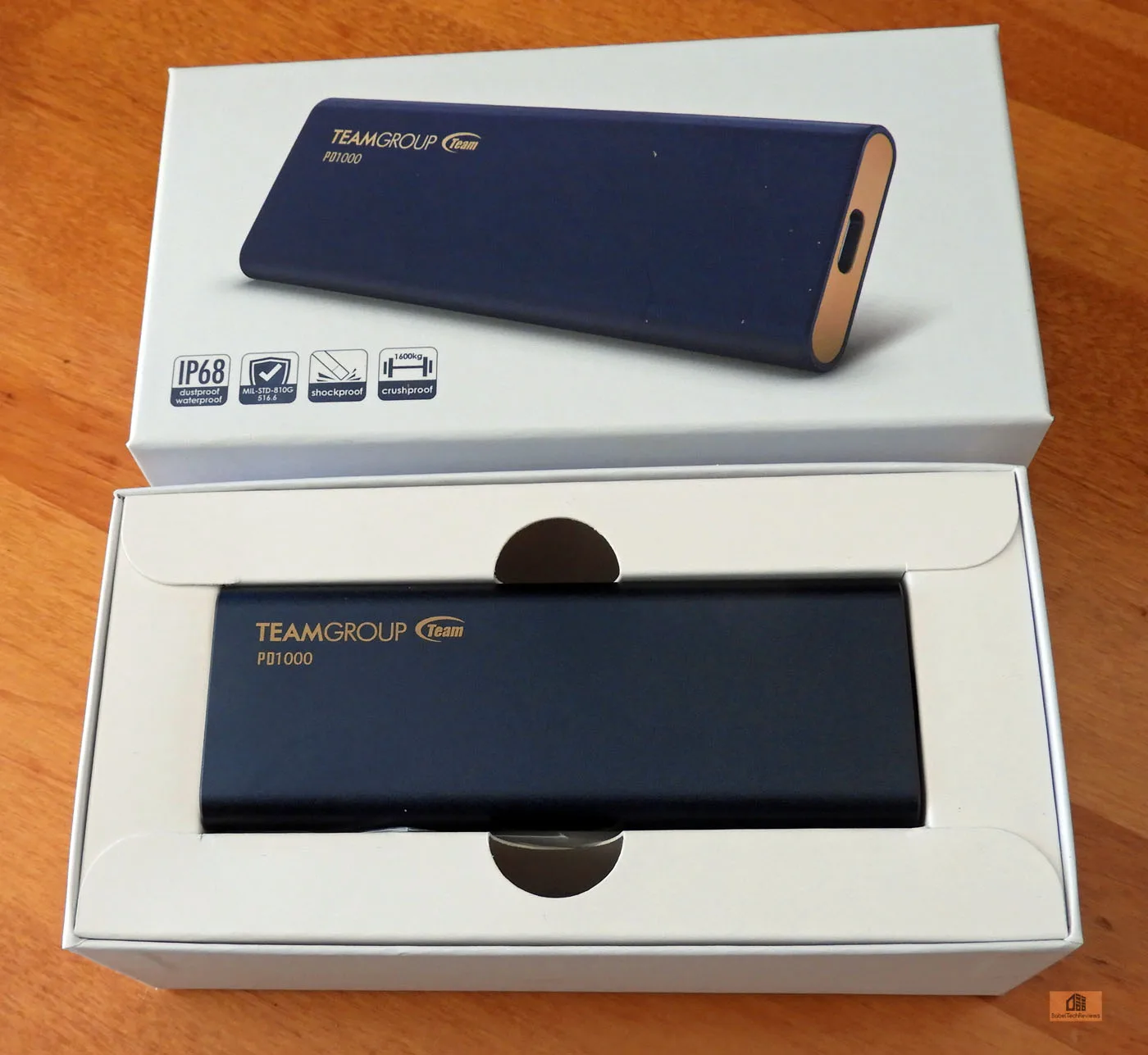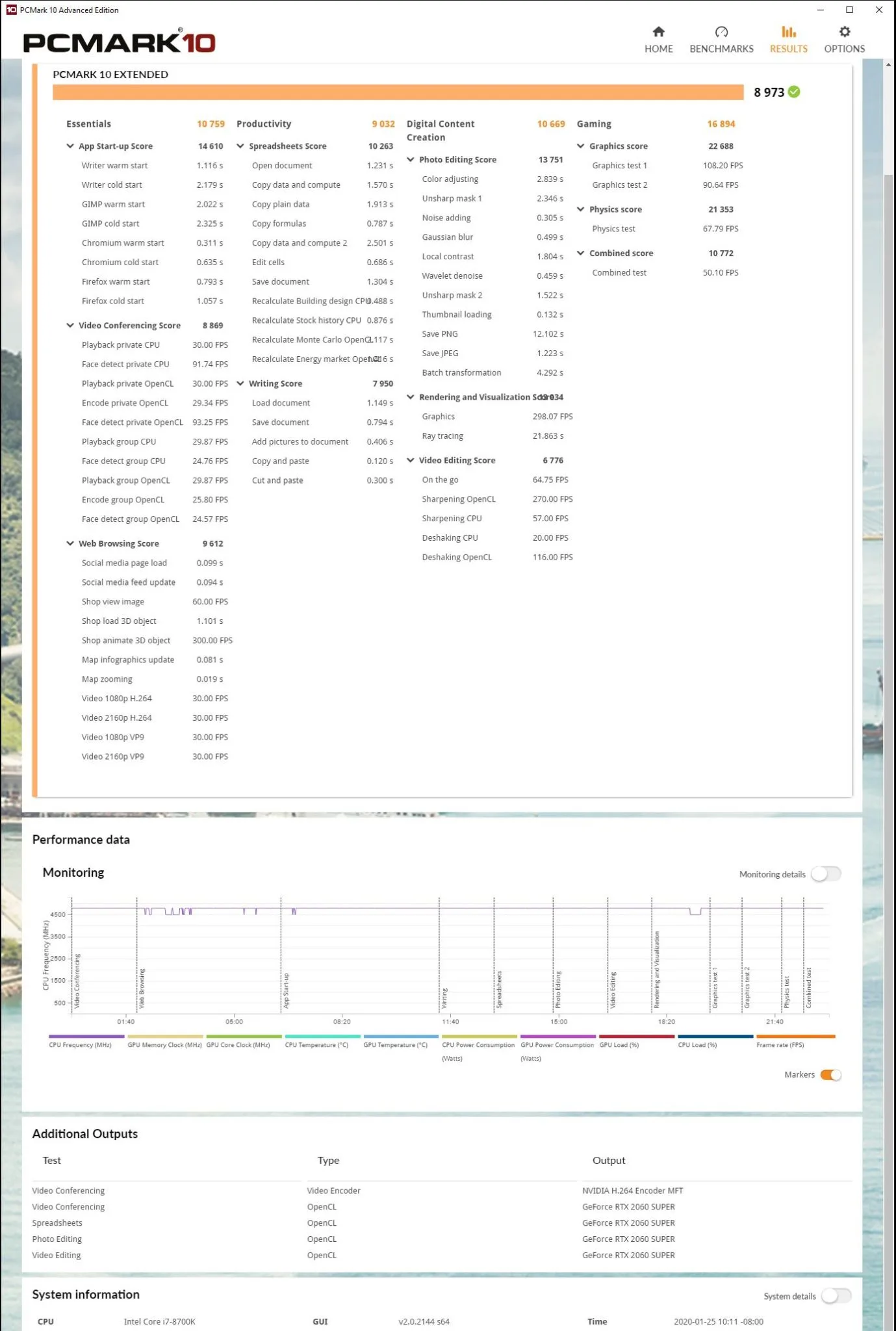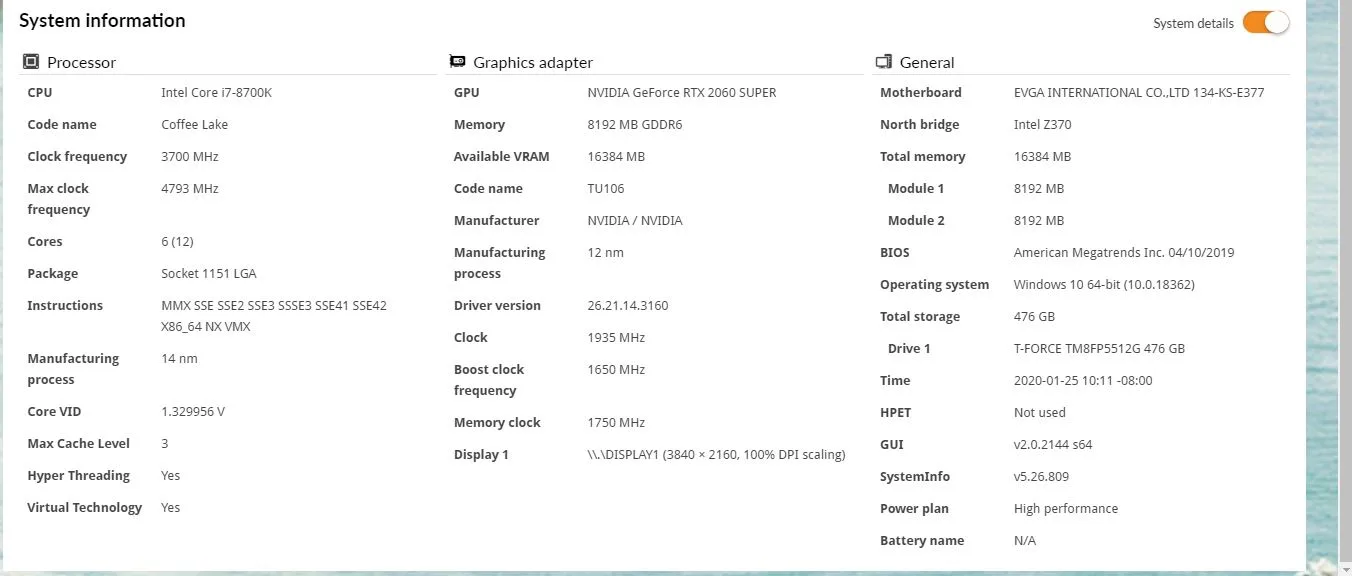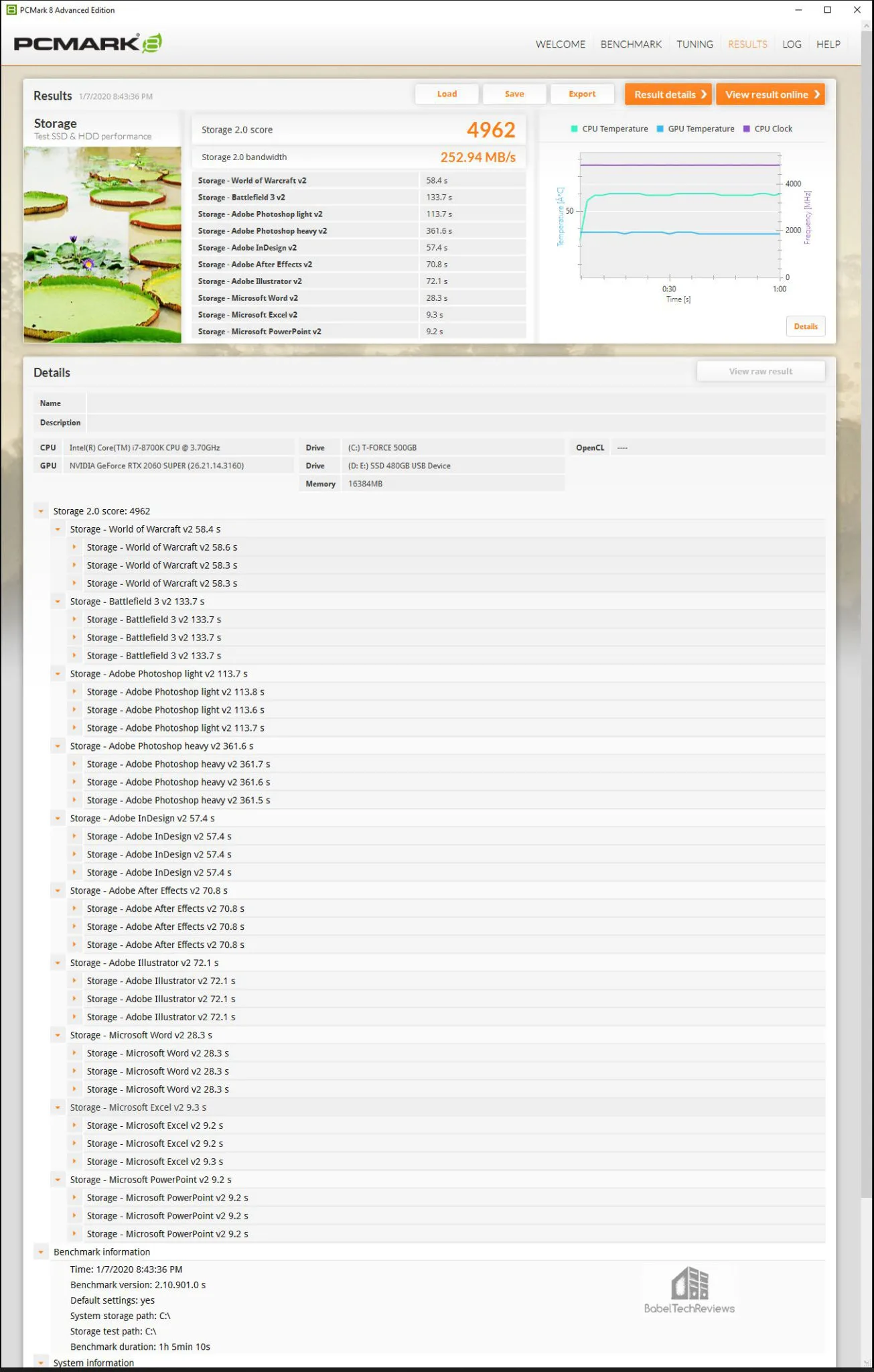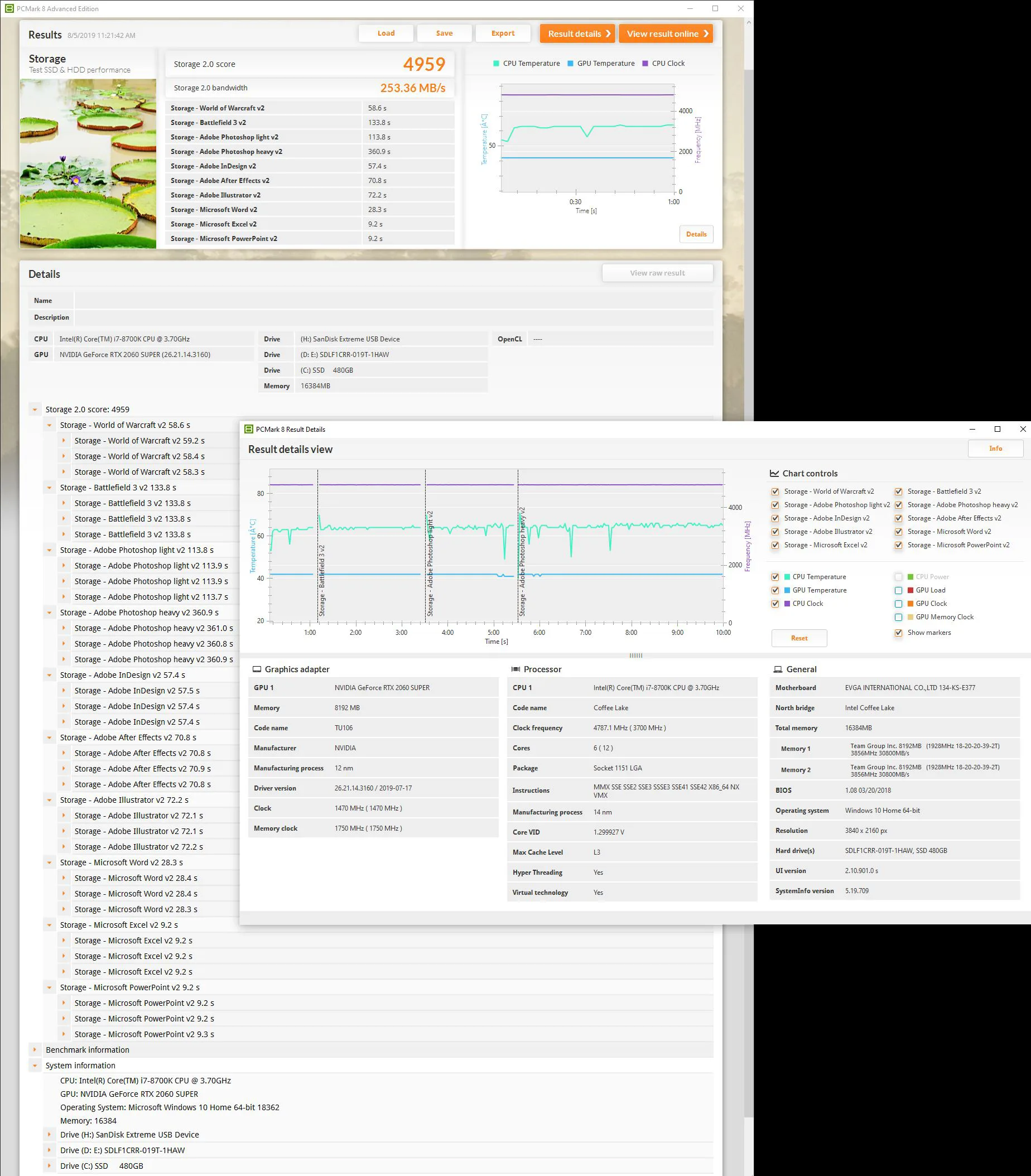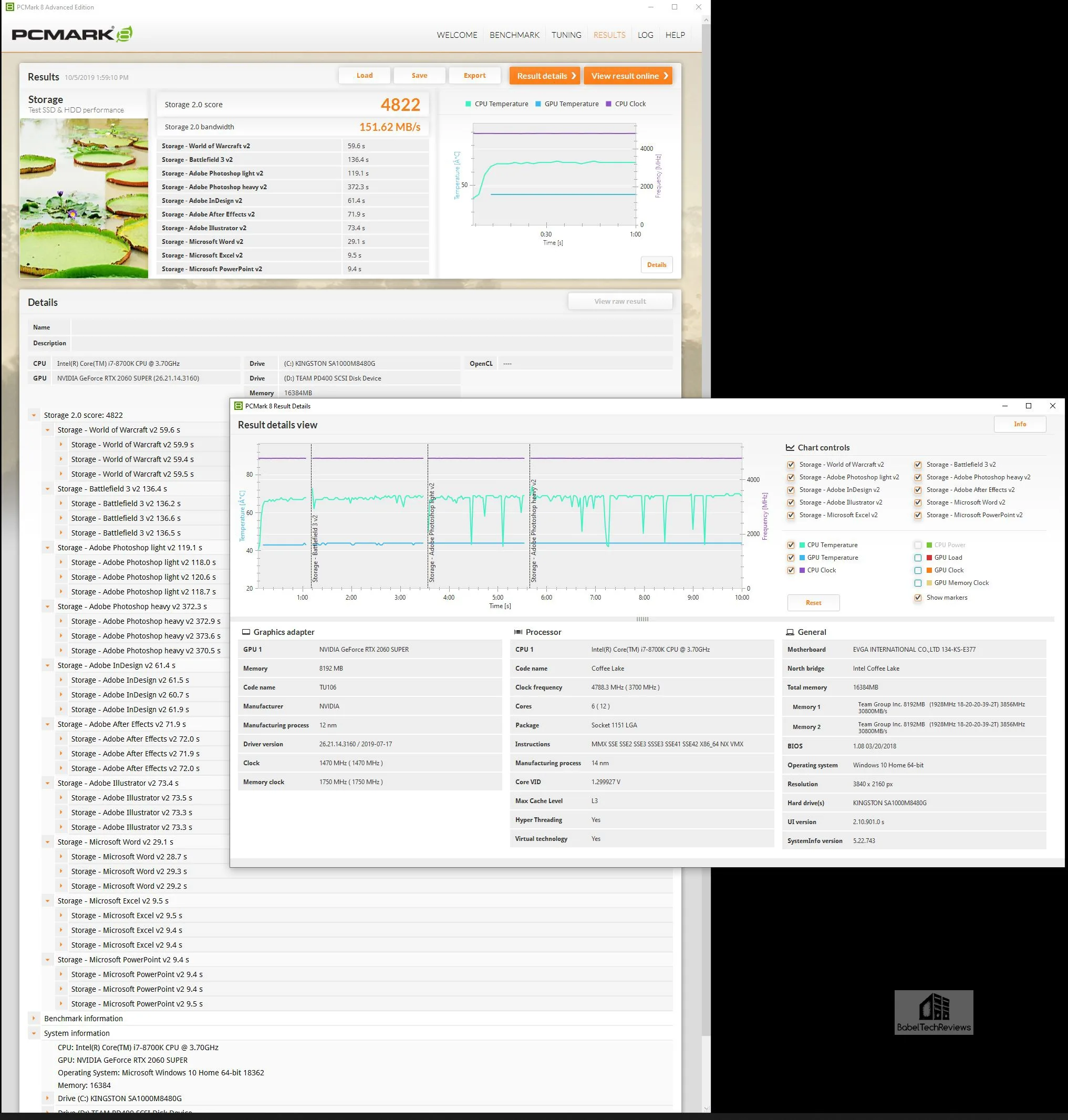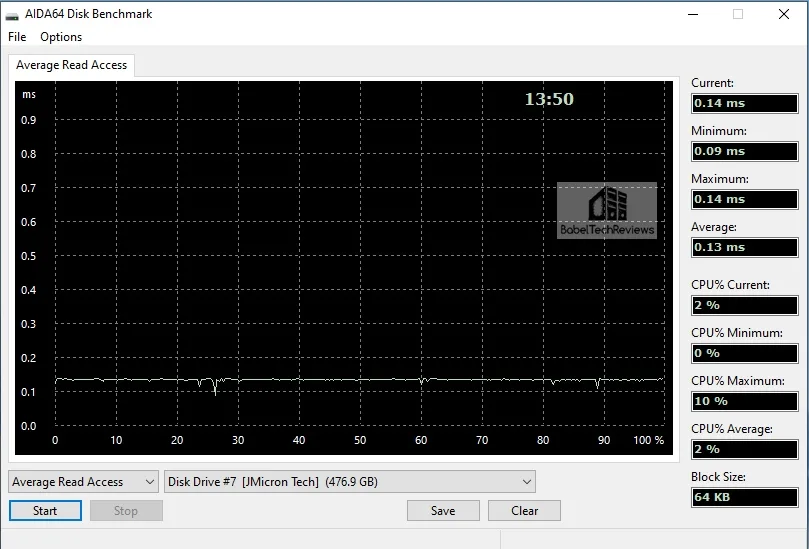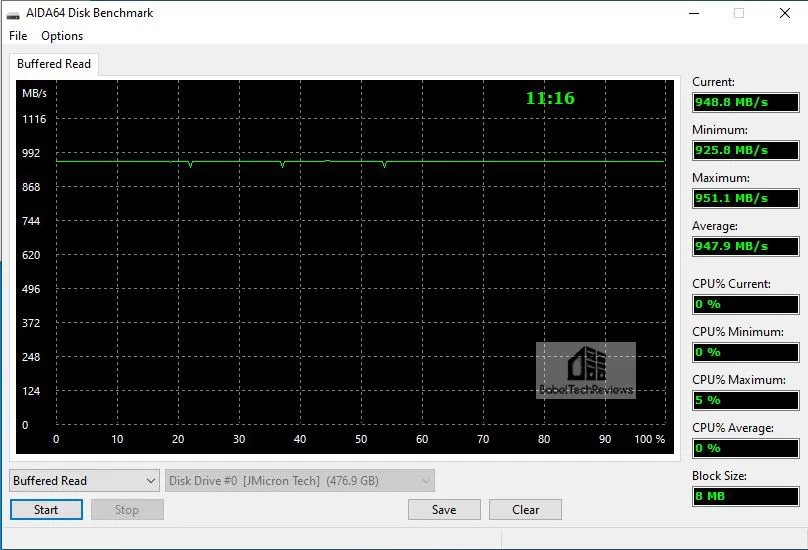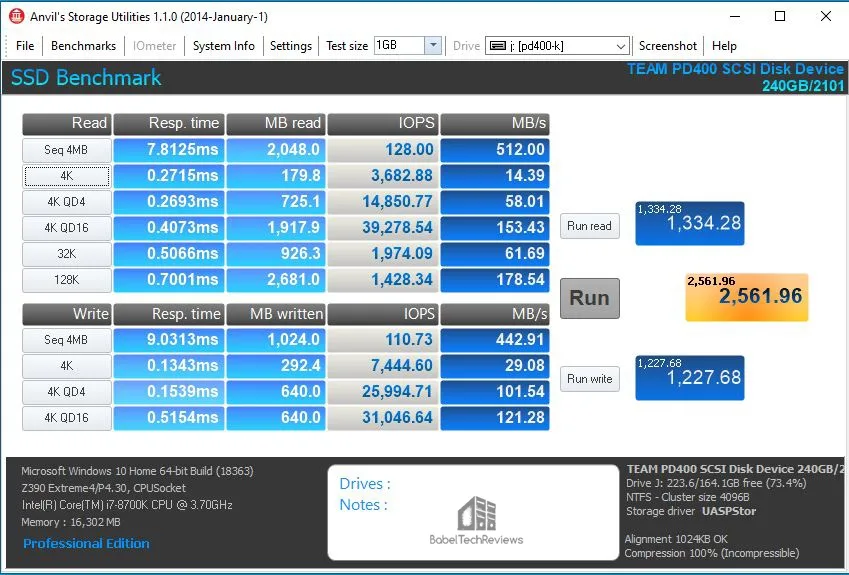The Team Group PD1000 Portable USB 3.2 Gen 2 512GB SSD Review – External USB 3.2 Type-C vs. Internal SATA III SSDs vs. SSHD vs. PCIe NVMe for Gaming
The Team Group PD1000 is an external portable USB 3.2 Gen 2 drive that may be suitable for gamers who may wish to install Win 10 and launch games from it instead of from an internal hard drive (HDD) or SSD. We are going to test the PD1000 review unit that we received from Team Group and compare its performance versus eight other drives to see if an external drive is an option for gaming.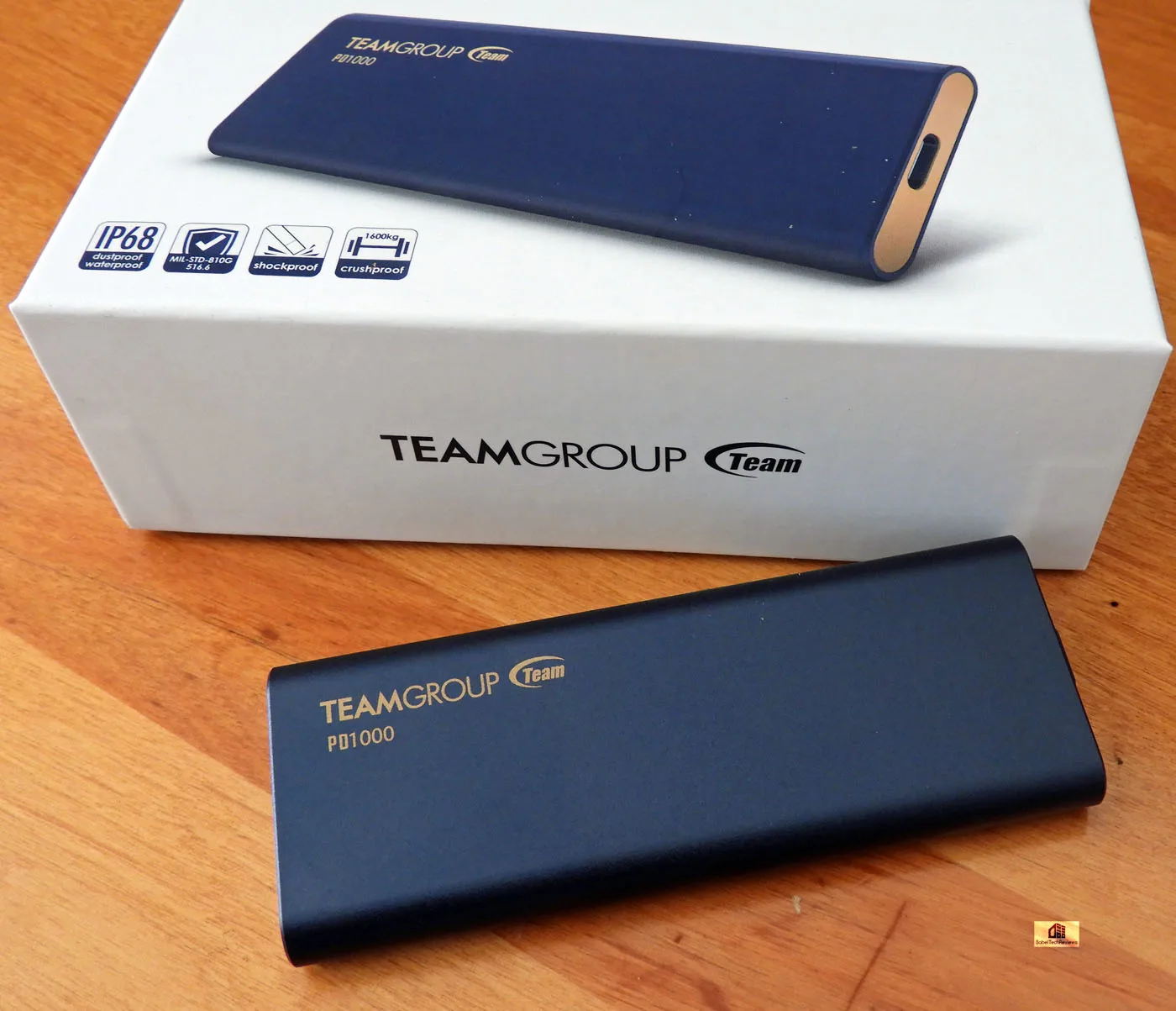
We have six SSDs (Solid State Drives) in BTR’s flagship PC with more than 3TB of total storage for games, and yet we always need more capacity. Using a HDD or a Solid State Hard Drive (SSHD) is out of the question because of how slowly they load games and levels compared to SSDs. Since USB 3.2 Gen 2 “super speed” is an upgrade over USB 3.0 with speeds to 10Gbps, it may be suitable to use the PD1000 as a primary operating system (OS) drive or for launching and playing games. It may be more convenient to simply plug the PD1000 into a USB port rather than to open up the PC, and this can be ideal for notebook gaming.
BTR previously used two identical 480GB Team Group L5 LTE SSDs as boot drives – one for AMD and one for NVIDIA – which have been recently upgraded to two 1TB Team Group MP33 NVMe2 PCIe 3.0 SSDs. Primary storage for our 50 PC games and 25 VR games are provided by enterprise SATA III SSDs: a 1.92TB SanDisk SSD and a 2TB Micron 1100 SSD. In addition, we also use a T-FORCE Vulcan SATA 500GB SSD and a 512GB DELTA MAX for additional storage, plus two 2TB Seagate FireCuda SSHDs which are relegated to backup duty.
For this review, we are going to compare the performance of eight drives to the portable Team Group 512GB PD1000 SSD which is $79.99 at Newegg; the MSRP is around $99. As a price comparison, the entry-level Team Group PD400 480GB USB 3.2 portable SSD has been on sale recently for $59.99 at Amazon but the suggested price is $77.03.
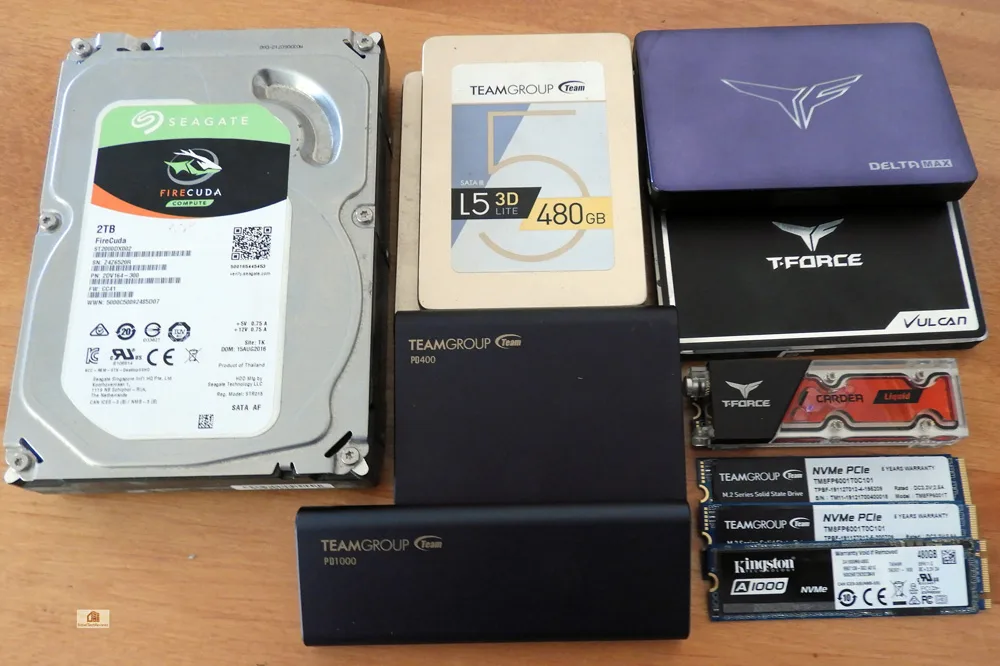
The T-FORCE Vulcan 500GB SATA III SSD can be found for $65.99; the DELTA MAX 500GB SATA III SSD is $89.99; the Kingston A1000 480GB NVMe SSD is overpriced at $106 but it has been replaced by the A2000; the Liquid CARDEA NVMe2 512GB drive is $110; the 480GB Team Group L5 SSD is $59.98; and a 2 TB FireCuda SSHD sells for $129 which is a 7200 rpm Seagate HDD coupled with 8 GB of flash drive. SSD pricing appears to be going up.
First, a warning. Be cautious about upgrading to the Windows 10 May Update 2004. It diminished performance in some benchmarks over version 1909. PCMark 10’s score dropped by 10% compared to version 1909, so we reverted to an earlier disk image. Since we have changed our motherboard from Z370 to Z390, we repeated many benchmarks so our readers have the very latest information, although it was not necessary.
BTR’s test setup uses Windows 10 64-bit featuring an Intel Core i7-8700K overclocked to 4.8GHz for all cores as set in the ASRock Z390 Extreme 4 motherboard’s BIOS, and 16 GB of T-FORCE XTREEM DDR4 at 3866MHz. The settings and hardware are identical except for the nine drives being tested, and the graphics are powered by a RTX 2060 SUPER Founders Edition (FE).
We benchmark with all of our drives at less than 80% capacity, and in addition, all of the drives have been in use for months except for the portable Team Group PD1000 SSD which has been “dirtied” using IOmeter, so our benchmarking tends to give more real world performance results over using brand new drives.
Here are the features and specifications of the Team Group PD1000 portable SSD taken directly from Team Group’s website.
FEATURES
- Great business appearance and excellent heat dissipating performance
- USB 3.2 Gen 2 super speed+ file transfer
- Certified military grade drop resistance
- IP68 waterproof, dustproof and pressure proof certification
- Supports multiple platform devices
Specifications
All of the details can be found on the Team Group website. The IP68 rating is not explained there, but it means that the PD1000 is “Protected from total dust ingress” as well as “The equipment is suitable for continuous immersion in water under conditions which shall be specified by the manufacturer”. Team Group specifies:
“Different from the dust plug design on the market, PD1000 comes with a complete covering. It can withstand 1 meter underwater for 60 minutes, completely isolate dust from entering, and withstand the weight of 1,600KG to protect your precious data.”
So as long as its included dust plug is inserted properly, you can probably take it with you while swimming although a large shark could damage it, and diving below 1 meter is not recommended. Interestingly, Team Group also told us that “It can have IP68 proof effect even if without the dust plug.”
Important key highlights are that the PD1000 external SSD is fast, durable, lightweight, shock resistant, uses very little power, and it is backed by Team Group’s 3-year warranty. Since USB 3.2 Generation 2 can reach speeds of up to 10Gbps, data transfers are usually faster than SATA III SSD speeds.
The PD1000 is compatible with Android, Mac OS, and Windows, and it supports hot swap so it can be connected to PCs, tablets, and notebooks without installing additional drivers. In addition, any heat generated by the internal SSD is transferred to the entire aluminum case which means that while in use it gets warm, but never hot.
The specifications look great for a portable external SSD. Let’s take a closer look by unboxing the Team Group PD1000 next.
Unboxing
The Team Group PD1000 512GB portable/external Type C USB 3.2 Gen 2 SSD comes in a large-for-its-size box which indicates it is IP68 rated as dustproof and waterproof, meets the military grade of 818G in the drop test; and is shockproof and crushproof.
The other side of the box gives specifications that indicate it is very fast with Read/Write speeds up to 1000/900MB/s. As a portable drive, it has a three year warranty.
The PD1000 is well protected in its box, but the unit is very durable with a “crushproof” rating of 1600kg – over 3500 pounds. You can probably drive a truck over the unit without crushing it.
The PD1000 will probably also be fine if you take it swimming. It is rated IP68 as dustproof and waterproof to 1 meter as long as the rubber plug is properly inserted.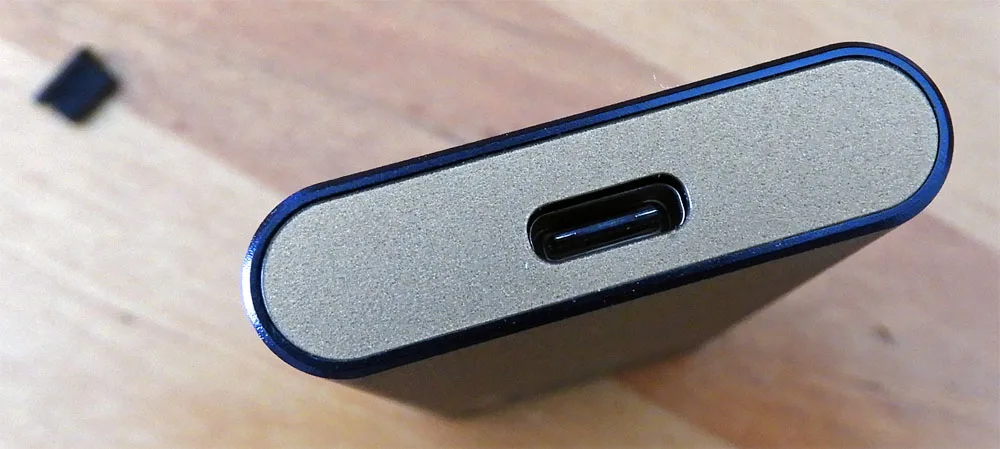
There is one connection and one rubber plug to keep the PD1000 water/dust resistant. Don’t lose the plug if you plan to use this drive as a portable SSD! The PD1000 looks great in a Navy Blue candy bar-type form factor since it houses a NVMe2 SSD inside. 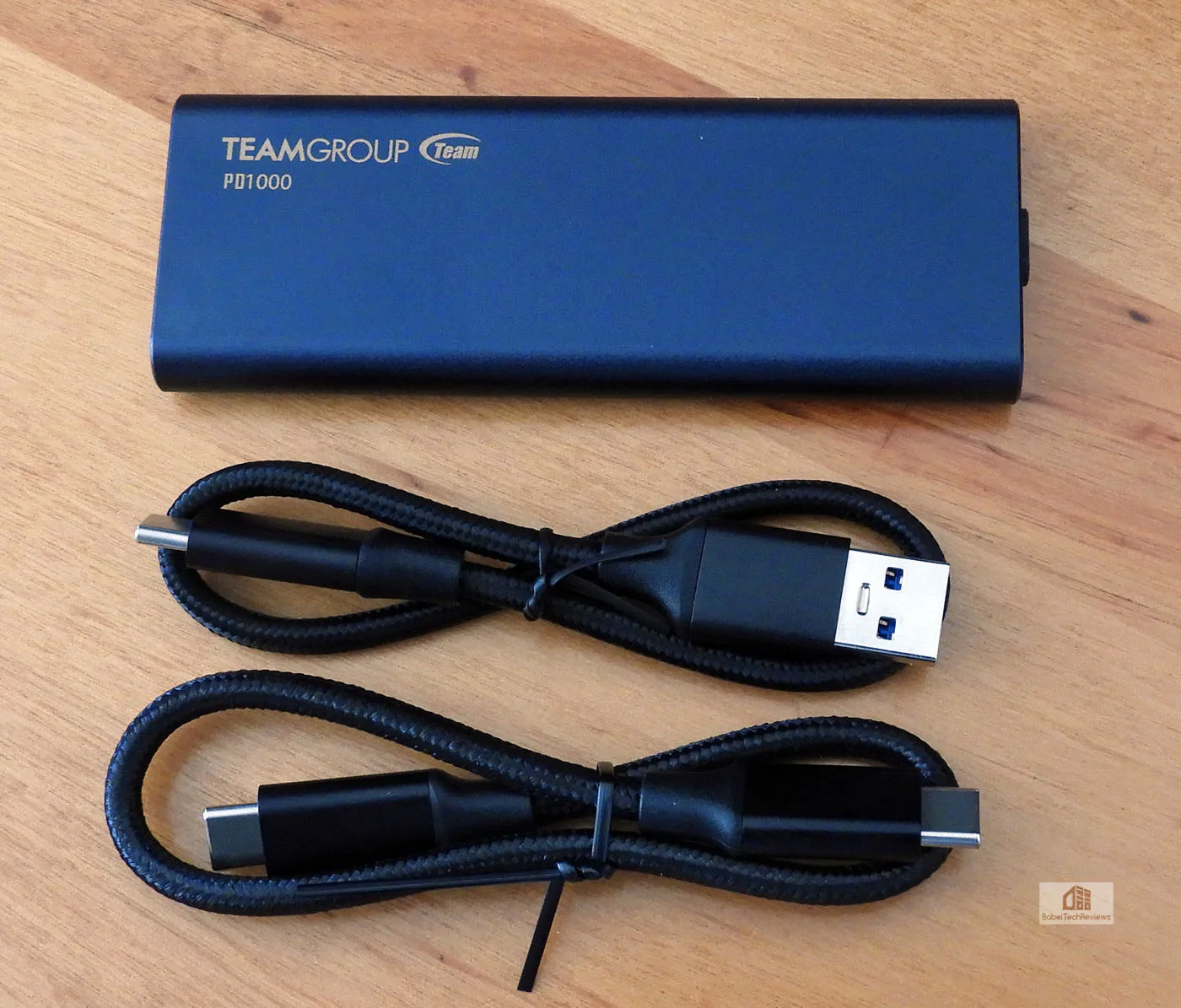
The PD1000 arrives with two cables. The first cable with a standard USB (Type-A) connector on one end can connect to any PC with a USB port, and its other end uses a USB Type-C connector to connect to the PD1000 SSD. The second cable has two USB Type-C connectors. We used the cable with two USB Type-C connectors for our benchmarking although there is no performance difference as long as the PC supports fast Gen 2 transfers over USB 3.2.
The other side shows the capacity which may be 512GB or 1TB.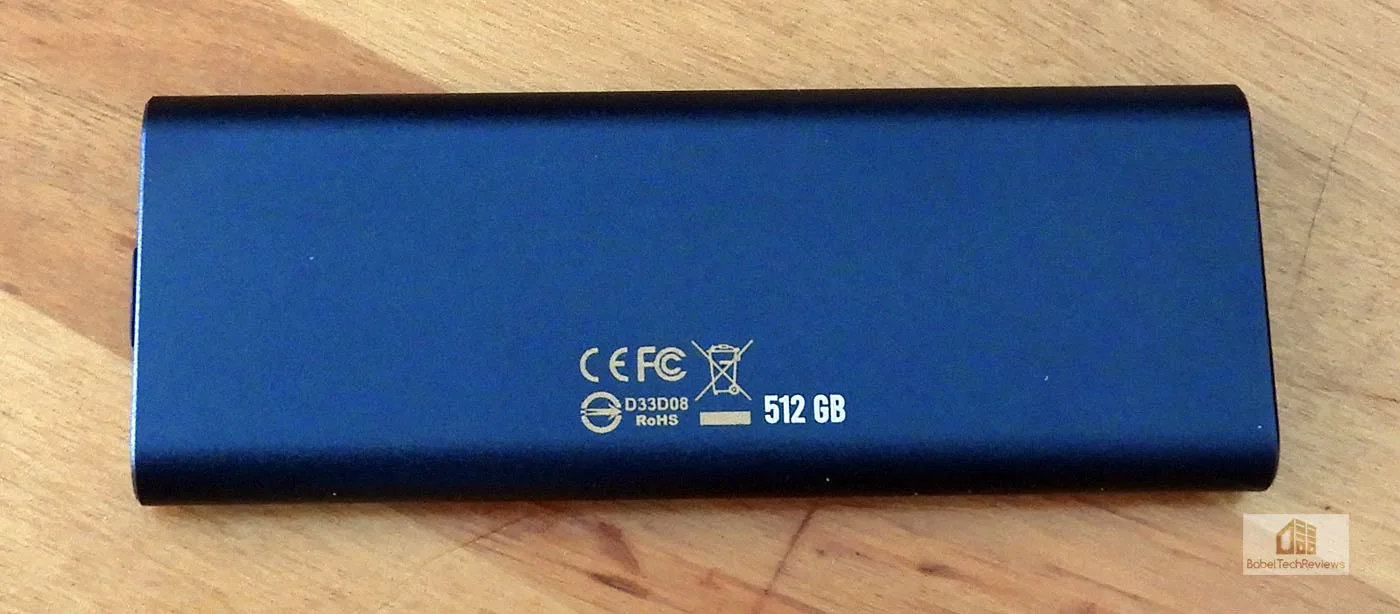
After installing the SSD, the user may need to format it before using it. The unit is identified as “JDMicron Tech” in Windows and by benchmarking programs.
This is our second review unit. The original had issues randomly disconnecting from our PC and Team Group informed us that ours was a rare assembly issue where the port connection did not make a solid contact. The second drive had no issues and we were never disconnected when we used the PD1000 as our primary drive.
Lets look at our test configuration next.
Test Configuration – Hardware
- Intel Core i7-8700K (HyperThreading and Turbo boost is locked on to 4.8 GHz for all six cores. Coffee Lake DX11 CPU graphics.
- ASRock Z390 Extreme 4 motherboard (Intel Z390 chipset, latest BIOS, PCIe 3.0/3.1/3.1 – USB 3.0 Type-C specification, CrossFire/SLI 8x+8x)
- T-FORCE XTREEM 16GB DDR4 (2x8GB, dual channel at 3866MHz), supplied by Team Group
- RTX 2060 Super Founders Edition 8GB, stock clocks, on loan from NVIDIA
- Team Group MP33 1TB NVMe2 PCIe SSD
- Team Group PD1000 External/Portable 512GB 3.2 USB Gen 2 SSD, supplied by Team Group
- Team Group PD400 External/Portable 240GB 3.2 USB Gen 2 SSD, supplied by Team Group
- T-FORCE DELTA MAX 500GB SATA III SSD, supplied by Team Group
- T-FORCE Liquid CARDEA 512GB SATA III SSD, supplied by Team Group
- T-FORCE Vulcan 500GB SATA III SSD, supplied by Team Group
- Kingston A1000 480GB NVMe PCIe SSD, supplied by Kingston
- Team Group L5 LITE 3D 480 GB SATA III SSD
- 2TB Seagate 7200 rpm SSHD (Solid State Hard Drive)
- Edifier R1280T active desktop speakers
- Grado SR60e headphones
- Monoprice Crystal Pro 4K
Test Configuration – Software
- Nvidia’s GeForce 446.14 WHQL drivers. High Quality, prefer maximum performance, single display
- Gaming results show loading time in seconds and lower is better
- Windows 10 64-bit Home edition, version 1909, latest updates
- Latest DirectX
- All benchmarking programs are updated to their latest versions
- MSI’s Afterburner to set the RTX 2060 Super power/temp limit to maximum
- IOmeter
- HD Tach
- HD Tune
- AS SSD
- ATTO
- Crystal DiskMark
PC Game & Level Loading Suite
- World of Warcraft (PCMark 8)
- Battlefield 3 (PCMark 8)
Synthetic Benching Suites
- SiSoft Sandra 2020
- AIDA64
- PCMark 8
- PCMark 10
- Anvil’s Storage Utilities
Let’s head to our benching results.
Benchmarking the PD1000
Benchmarking SSDs are not an exact science as there is variability between runs, and different benchmarks may show different results depending on how they run their tests and how up-to-date the benchmarks are. However, by using enough real world and synthetic tests, it may be possible to get a good idea of relative performance across all nine tested drives.
For benchmark results, the drives are generally listed in the following order:
- Team Group PD1000 512GG USB 3.2 Gen 2 portable SSD
- Kingston A1000 480GB NVMe2 SSD
- Team Group MP33 1TB NVMe2 SSD
- T-FORCE Liquid CARDEA 500GB NVMe2 SSD
- T-FORCE Vulcan 500GB SATA III SSD
- T-FORCE DELTA MAX 500GB SATA III SSD
- Team Group L5 LITE 3D 480GB SATA III SSD
- Team Group PD400 240GB USB 3.2 Gen 2 portable SSD
- Seagate FireCuda 2TB SSHD (solid state hard drive)
Let’s start with PCMark 10 and see if the external Team Group PD1000 can compete with internal SSDs.
PCMark 10
UL (formerly Futuremark) is a developer and publisher of PC benchmark applications for nearly two decades. Although PCMark benches are synthetic tests, they provide a good measure of system performance. PCMark 10 was primarily developed for Windows 10 and it builds upon the PCMark 8 platform for a package of vendor-neutral home and office benchmarks.
Unfortunately, in comparison to PCMark 8, PCMark 10 is missing key elements including detailed storage testing, and it is not possible to test attached drives as with the earlier suite. We installed Windows 10 on the PD1000 and used it as our boot drive over USB 3.2 but did not install nor benchmark PCMark 10 on the portable 240GB Team Group SSD. We use PCMark 10’s Extended settings.
To properly compare the PCMark 10 scores, look at the detailed results that you want to compare. All eight tested drives’ results are presented as screenshots. Open the images in separate tabs for easy detailed test comparisons. First up are the Team Group PD1000 scores.
The Team Group PD1000 512MB SSD scores 8220.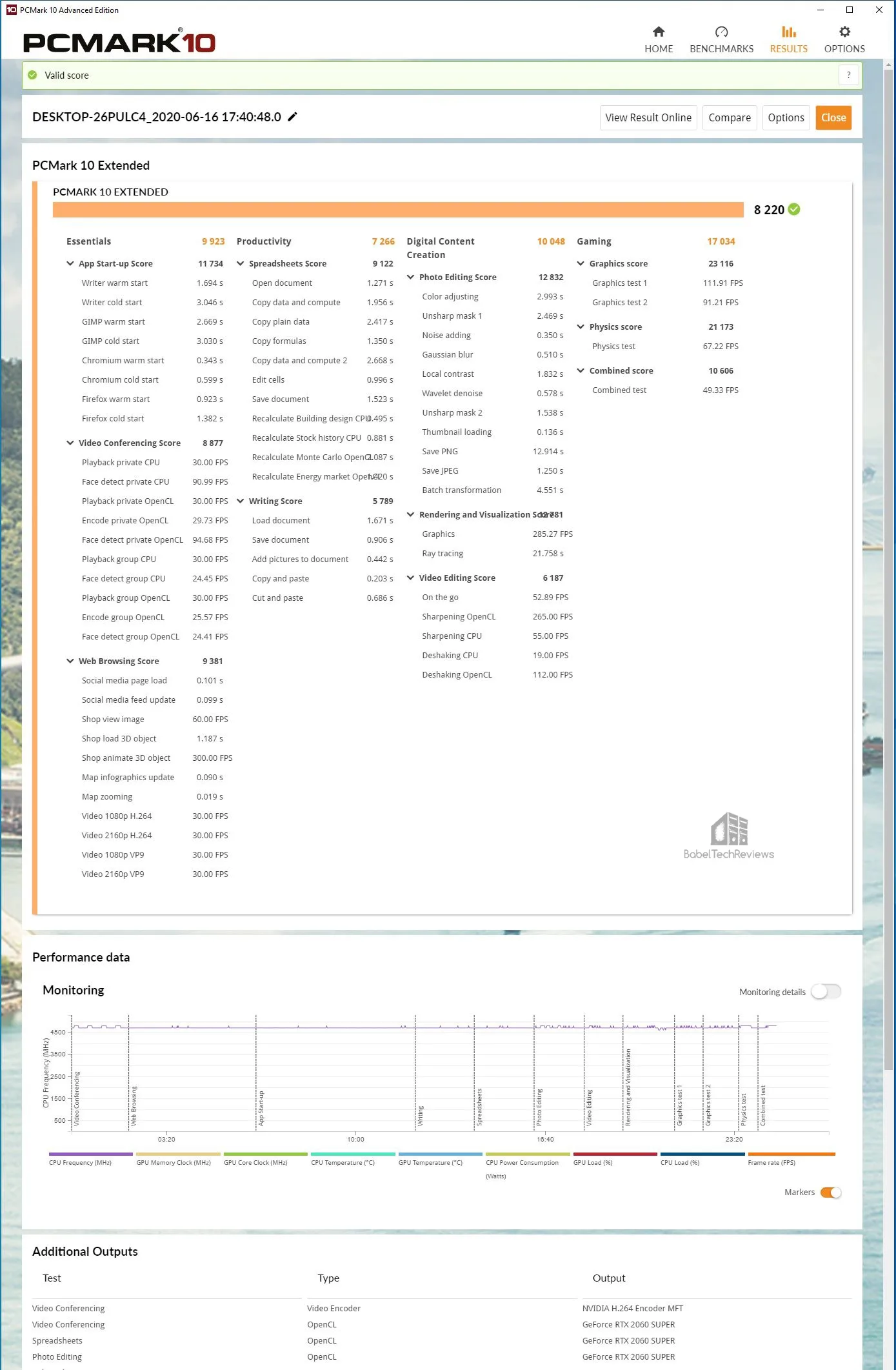

Here are the PD1000 results validated online.
The Kingston A1000 480 GB SSD scores 8863 which is ahead of the PD1000 PC score.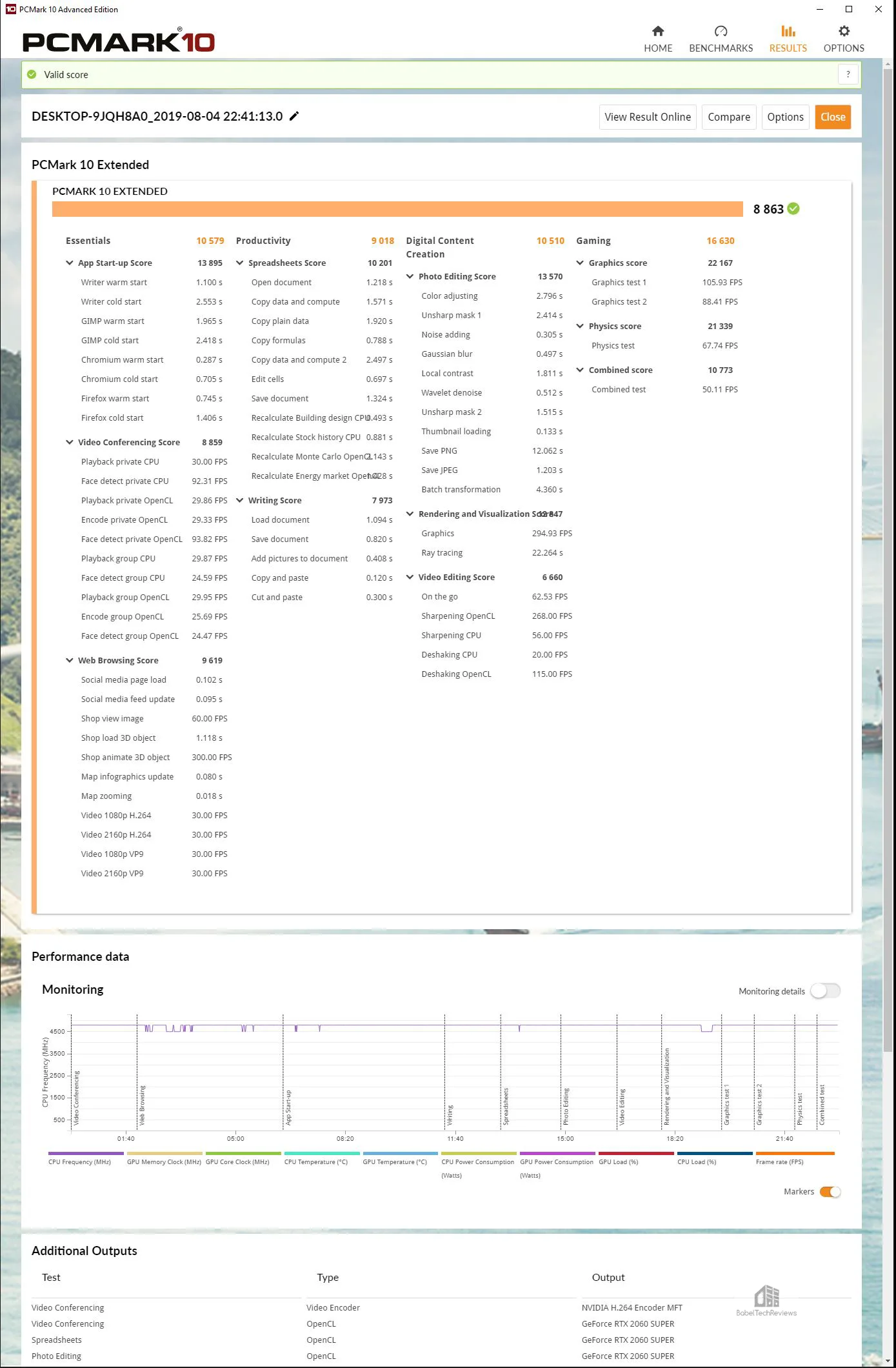
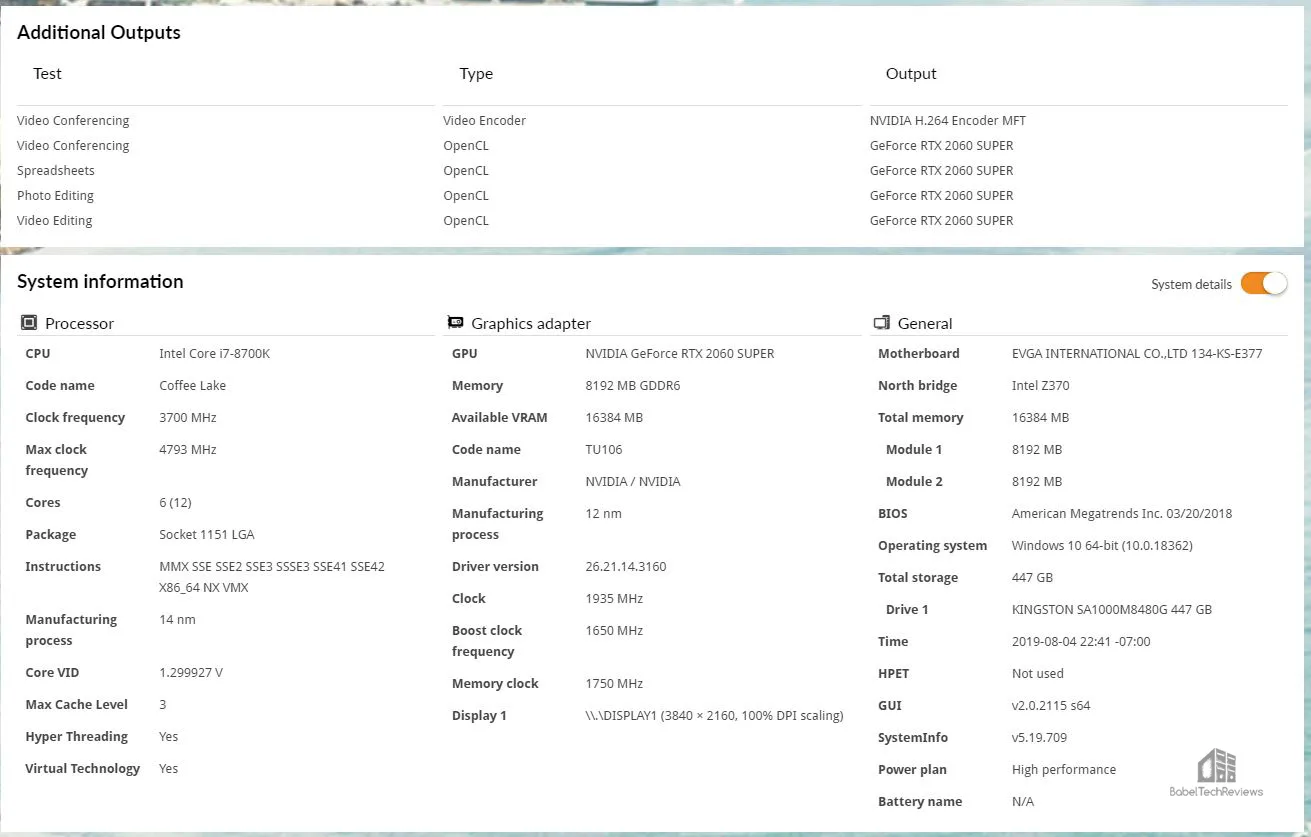 The Team Group MP33 M.2 PCIe 1TB SSD scores 8987, the highest PCMark 10 score of our SSDs.
The Team Group MP33 M.2 PCIe 1TB SSD scores 8987, the highest PCMark 10 score of our SSDs.
The CARDEA Liquid 500 GB SSD system scores 8973 which is ranked second by PCMark 10 even though it is the overall fastest SSD that we tested.
The T-FORCE Vulcan 500GB SSD scores 8880.

The T-FORCE DELTA MAX 500GB SSD scores 8849.
The Team Group L5 LTE 3D 480GB SSD scores 8831.
 The FireCuda 2TB SSHD scores 7883.
The FireCuda 2TB SSHD scores 7883.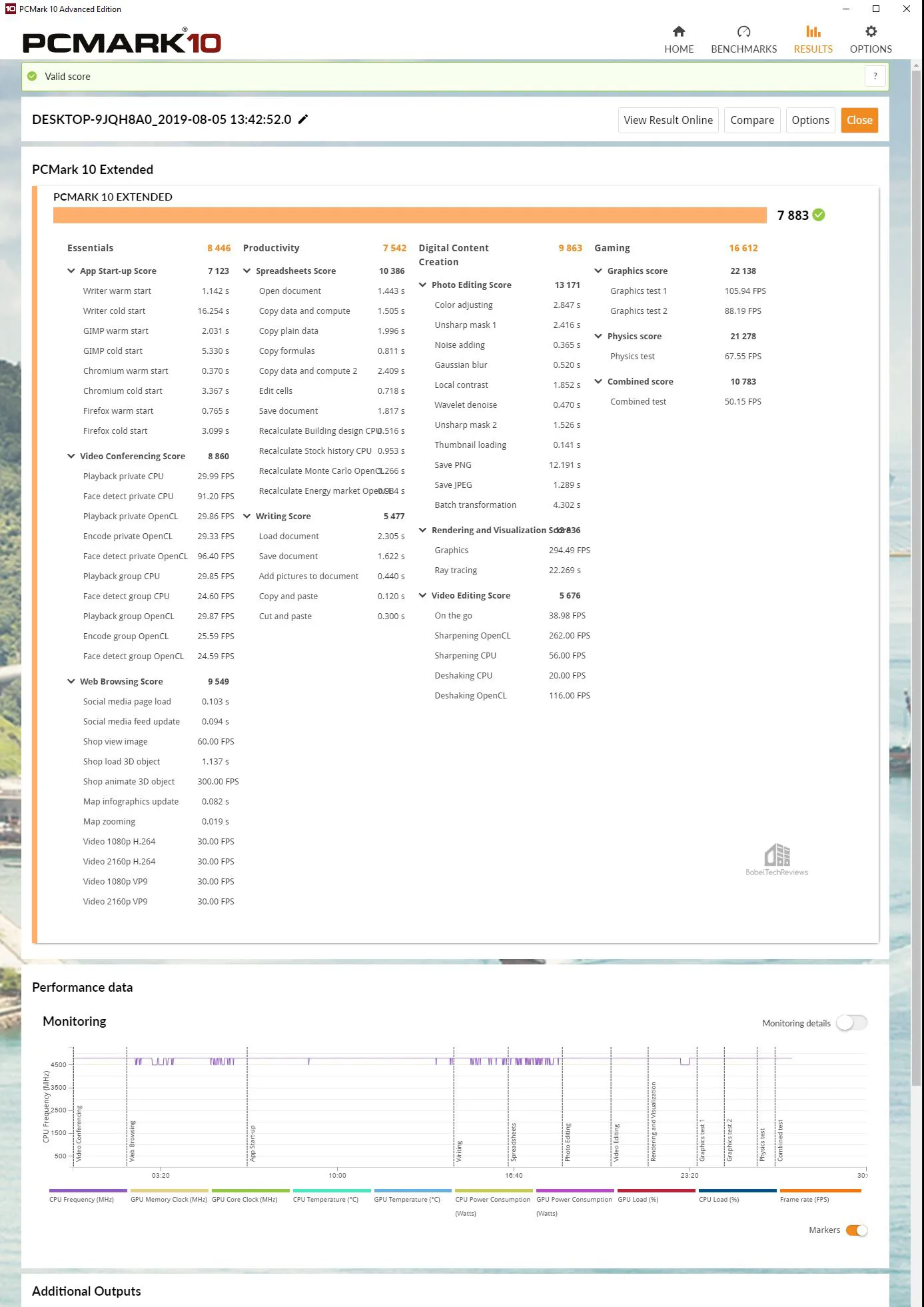
 Here is the summary of the eight drives that were tested.
Here is the summary of the eight drives that were tested.
Let’s check out PCMark 8 which uses better dedicated storage tests.
PCMARK 8
PCMark 8 has an excellent storage test which actually uses real world timed gaming benchmarks that include loading World of Warcraft and Battlefield 3 as well as timing how long it takes to load popular Adobe and Microsoft apps.
The Team Group PD1000 512MB SSD scores 4998 with a total Storage 2.0 Bandwidth of 313.80 MB/s. And of particular interest for gamers, it took 58.2 seconds to load World of Warcraft and 133.4 seconds for Battlefield 3 to load.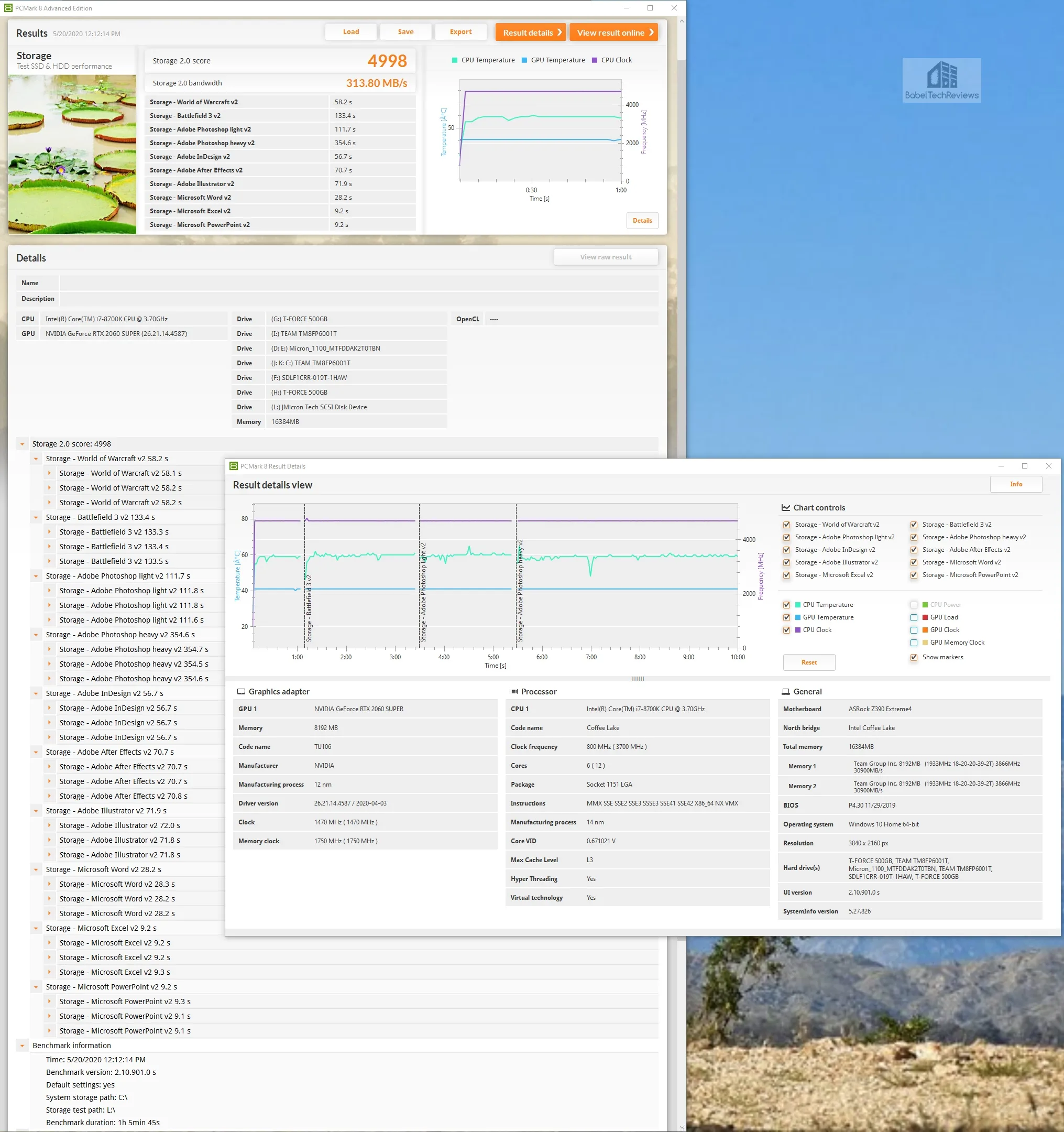
Here are the PD1000 online results: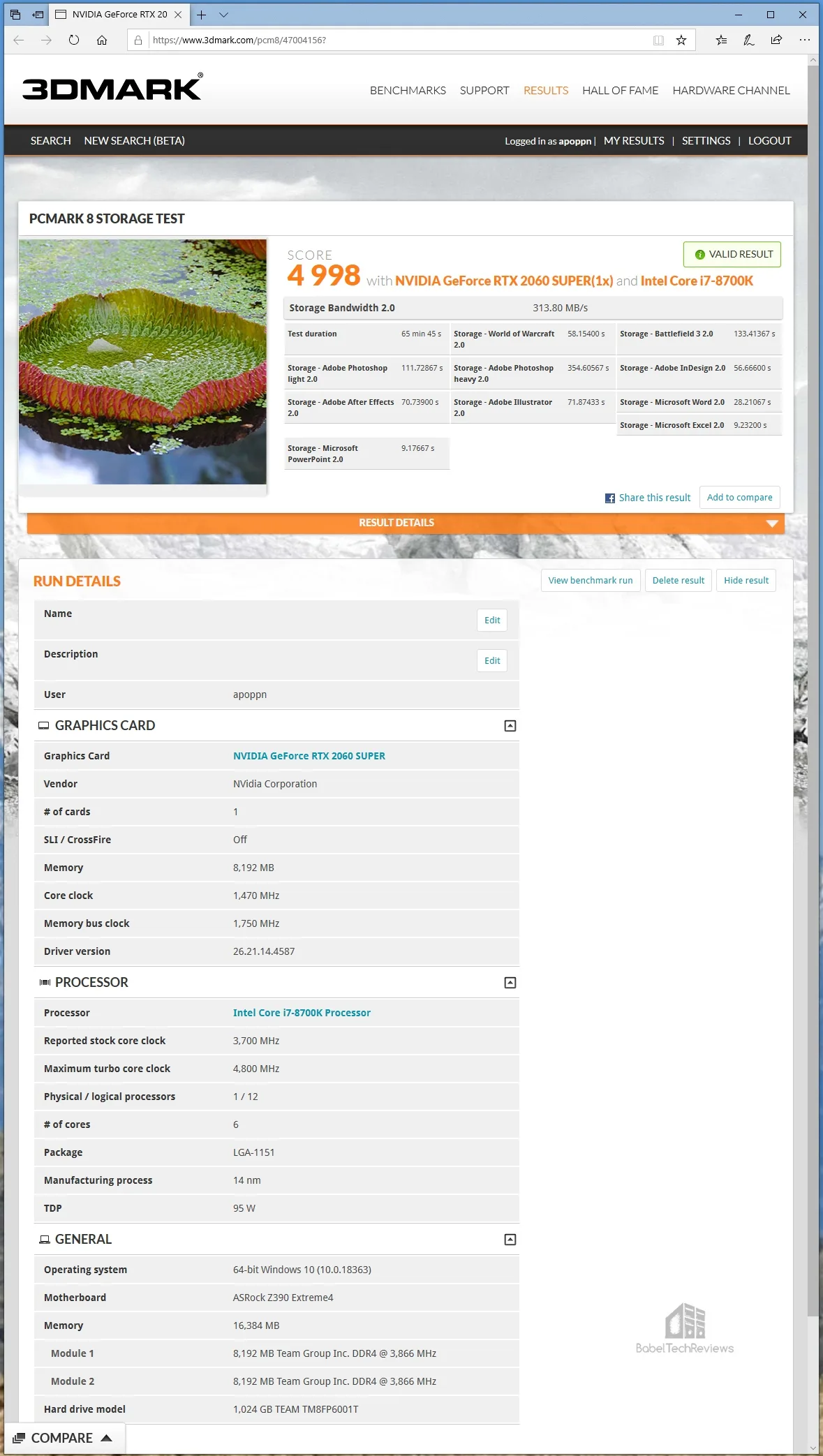
The Kingston A1000 480 GB SSD scores 5032 with a total Storage 2.0 Bandwidth of 401.30 MB/s. Of interest to gamers, it took 58.0 seconds to load World of Warcraft and 132.6 seconds for Battlefield 3 to load.
The Team Group MP33 M.2 PCIe 1TB SSD scores 5039 with a total Storage 2.0 Bandwidth of 410.40 MB/s. It took 58.2 seconds to load World of Warcraft and 132.7 seconds for Battlefield 3 to load.
The T-FORCE CARDEA Liquid 500GB SSD scores 5076 with a total Storage 2.0 Bandwidth of 599.03 MB/s. It took 57.4 seconds to load World of Warcraft and 131.5 seconds for Battlefield 3 to load.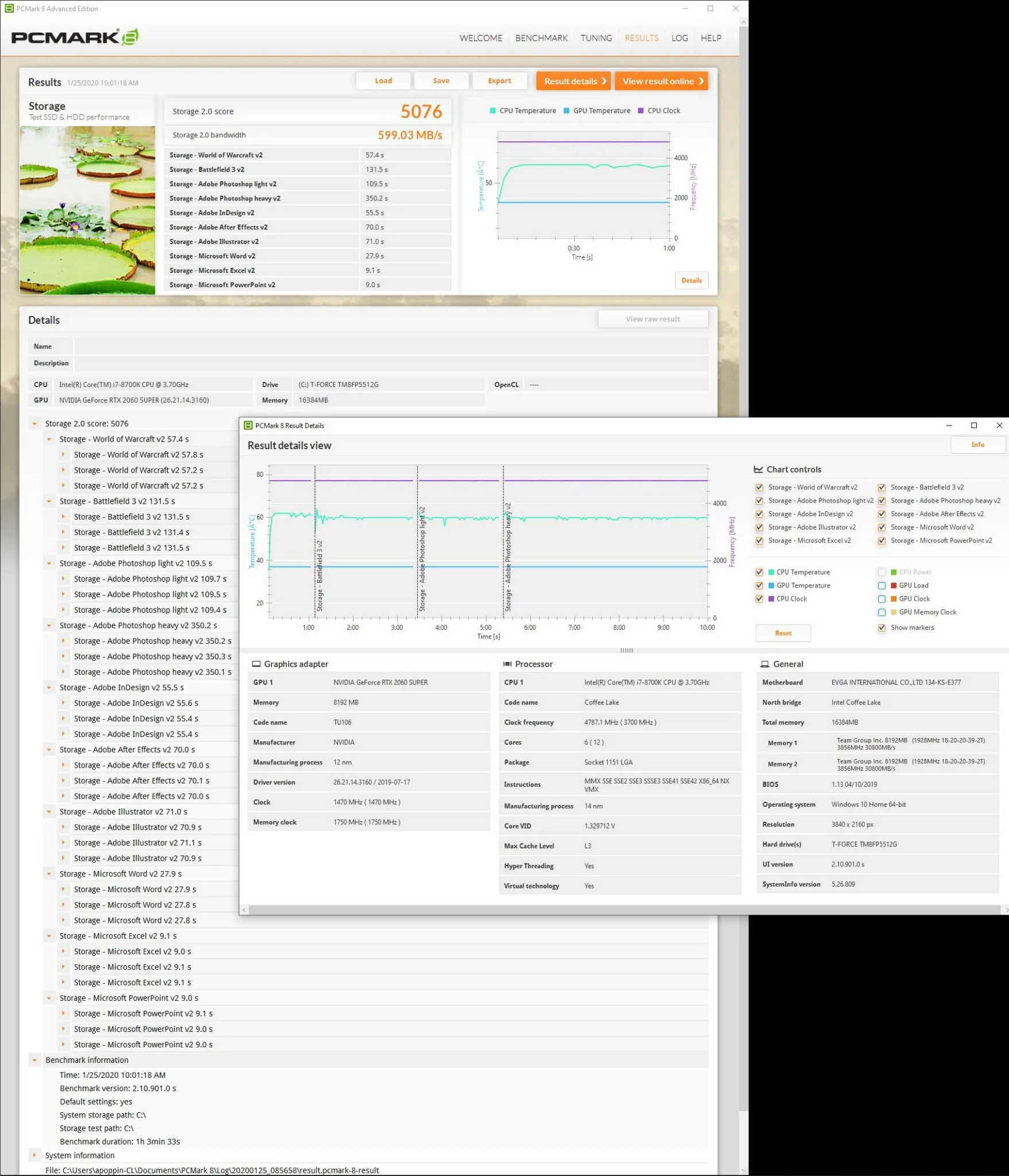
The T-FORCE Vulcan 500GB SSD scores 4985 with a total Storage 2.0 Bandwidth of 295.60 MB/s. And most importantly for a gamer, it took 58.2 seconds to load World of Warcraft and 133.2 seconds for Battlefield 3 to load.
The T-FORCE DELTA MAX 500GB SSD scores 4962 with a total Storage 2.0 Bandwidth of 252.94 MB/s. It took 58.4 seconds to load World of Warcraft and 133.7 seconds for Battlefield 3 to load.
The Team Group L5 3D 480GB SSD scores 4959 with a total Storage 2.0 Bandwidth of 253.36 MB/s. It took 58.6 seconds to load World of Warcraft and 133.8 seconds for Battlefield 3 to load.
The Team Group PD400 240GB portable SSD scores 4822 with a total Storage 2.0 Bandwidth of 151.62 MB/s. It took 59.6 seconds to load World of Warcraft and 136.4 seconds for Battlefield 3 to load.
Here are the 2TB SSHD storage test results scoring 3267 and 21.73 MB/s bandwidth. It took a rather long 97.1 seconds to load World of Warcraft and 250.3 seconds for Battlefield 3 to load.
Below are the comparative overall PCMark 8 scores that include gaming loading times and storage bandwidth results. The game loading time results are charted first, and since we are measuring time in seconds, lower is better. Surprisingly, the PD1000 portable USB 3.2 SSD actually loads games slightly faster than any SATA III SSD, and it competes very well with the NVMe2 SSD game loading speeds. In contrast to using any SSD, using the SSHD takes nearly twice as long to load the same games. SSHDs only speed up after repeated loading of levels or games, and after 2 or 3 loads it will set up more quickly approaching SSD speeds.
Surprisingly, the PD1000 portable USB 3.2 SSD actually loads games slightly faster than any SATA III SSD, and it competes very well with the NVMe2 SSD game loading speeds. In contrast to using any SSD, using the SSHD takes nearly twice as long to load the same games. SSHDs only speed up after repeated loading of levels or games, and after 2 or 3 loads it will set up more quickly approaching SSD speeds.
The PD1000 scores well with PCMark 8 in the storage test in every metric where higher is better. Let’s look at the characteristics of the drive as reported by Sandra 2020
SiSoft Sandra 2020
To see exactly where drive performance results differ, there is no better tool than SiSoft’s Sandra 2020. Sandra (the System ANalyser, Diagnostic and Reporting Assistant) is a complete information & diagnostic utility in one package. It is able to provide all of the information about your hardware, software, and other devices for diagnosis and for benchmarking. The name, Sandra, is derived from a Greek name that implies “defender” or “helper”.
There are several versions of Sandra 2020, including a free version of Sandra Lite that anyone can download and use. It is highly recommended. The SiSoft’s Sandra 2020 Release 6 is the latest version, and we are using the full engineer suite courtesy of SiSoft. It can benchmark and analyze all of the important PC subsystems and even rank a PC as well as make recommendations.
Here are the Sandra disk benchmarking tests in a single chart summarizing the performance results of our nine drives. Higher denotes better performance except for Access time where lower is better.
The NVMe2 Liquid CARDEA is the fastest drive that we tested followed by the NVMe2 MP33 SSD. The overall performance of both the external PD1000 and the Kingston A1000 NVMe SSD are faster than the other three SATA III SSDs. The Team Group USB 3.1 PD400 is the slowest SSD but it is solidly faster than the SSHD which is always in last place.
AIDA64 v6.0
AIDA64 is the successor to Everest and it is an important industry tool for benchmarkers. AIDA64’s benchmark code is written in Assembly language, and they are well-optimized for AMD, Intel and VIA processors by utilizing the appropriate instruction set extensions. We use the Engineer’s version of AIDA64 courtesy of FinalWire. AIDA64 is free to to try and use for 30 days.
We run the AIDA64 overall Disk Benchmark and the 4 individual Read tests for each drive, and we include the image for the tests and then summarize all of our drive results in a chart. These tests are very detailed, and since there are a lot of customization options available we run the default tests. We did not run the Read tests as they will destroy the data on the disks being tested.
- The Linear Read test measure sequential performance by reading or writing all sectors without skipping any. It’s a linear view of the drives overall performance from its beginning to end.
- The Random Read test measures the random performance by reading variable-sized data blocks at random locations on the drive and they are combination of both speed and access times as its position changes before each new operation.
- The Access time tests are designed to measure the data access performance by reading 0.5 KB data blocks at random drive locations.
- The Buffered Read test measures the drive caching.
The overall disk benchmark is relatively quick, but the individual benchmarks take much longer. Here are the PD1000 Read Test Suite benchmark results.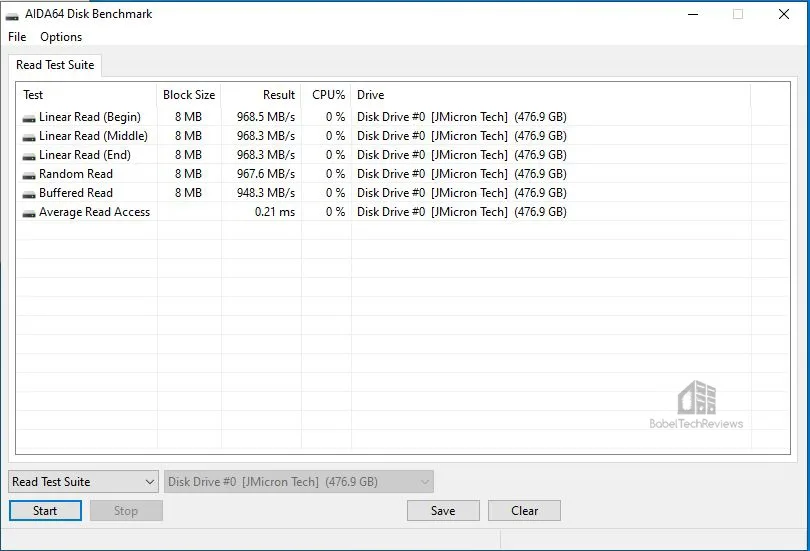
Below are the PD1000’s detailed individualized Read tests.
Here is the summary chart comparing our nine tested drives where higher is better except for the Average Read Access where lower is better.
The results are impressive for a portable SSD drive. Although the CARDEA Liquid and the MP33 NVMe2 SSDs lead the pack, both the PD1000 and the Kingston A1000 NVMe SSD are ahead of the SATA III based SSDs which are in turn faster than the external PD400 which is again much faster than the SSHD. Let’s check out a new (for BTR) benchmark, Anvil’s Storage Utilities.
Anvil’s Storage Utilities
Anvil’s Storage Utilities is a tool designed to benchmark and evaluate the Read and Write performance of SSDs and HDDs. It gives overall bandwidth as well separate Read and Write scores, the response times, and IOPS capabilities.
Here are the PD1000 portable SSD results.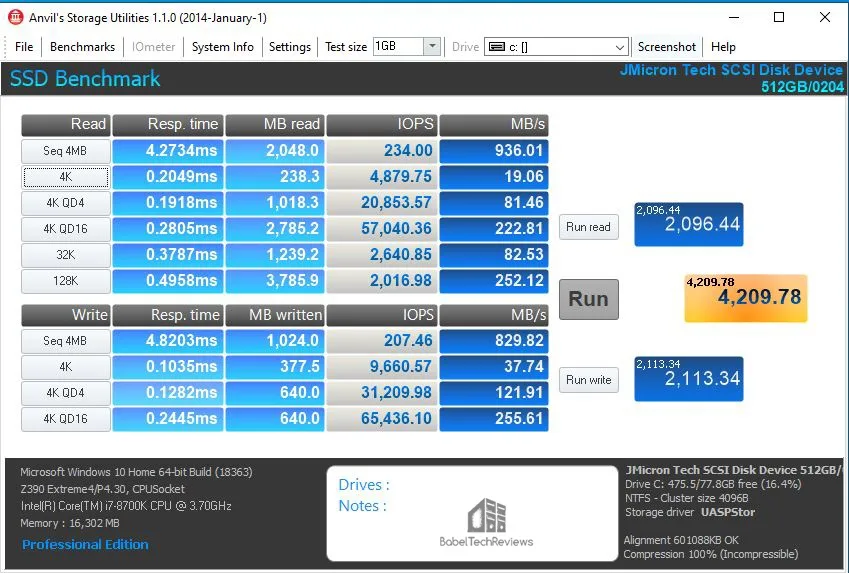
Kingston’s A1000 NVMe2 SSD scores higher.
Team Group MP33 NVMe2 SSD is the second fastest drive.
The Liquid CARDEA NVMe2 SSD is the fastest SSD.
T-FORCE Vulcan SSD is the fastest SATA III drive but it scores lower than the PD1000.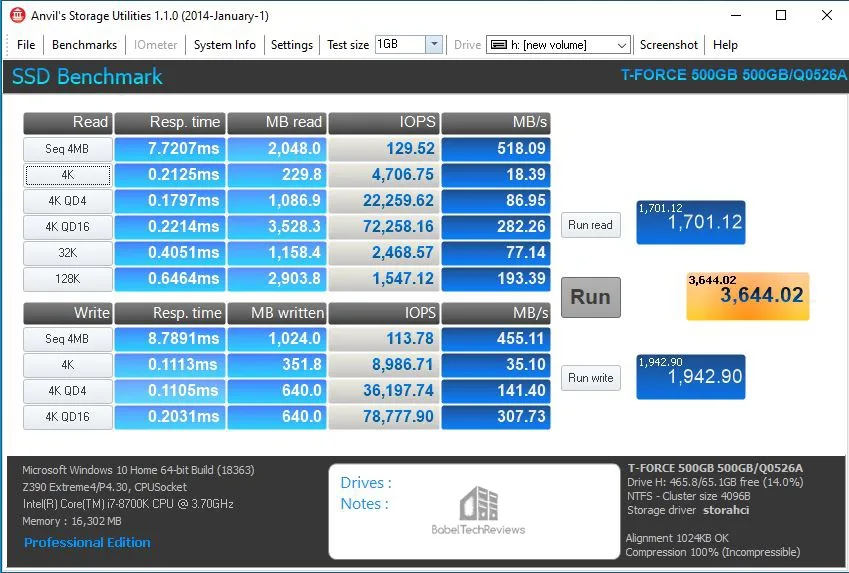
T-FORCE DELTA MAX drive is the the third fastest SATA III SSD.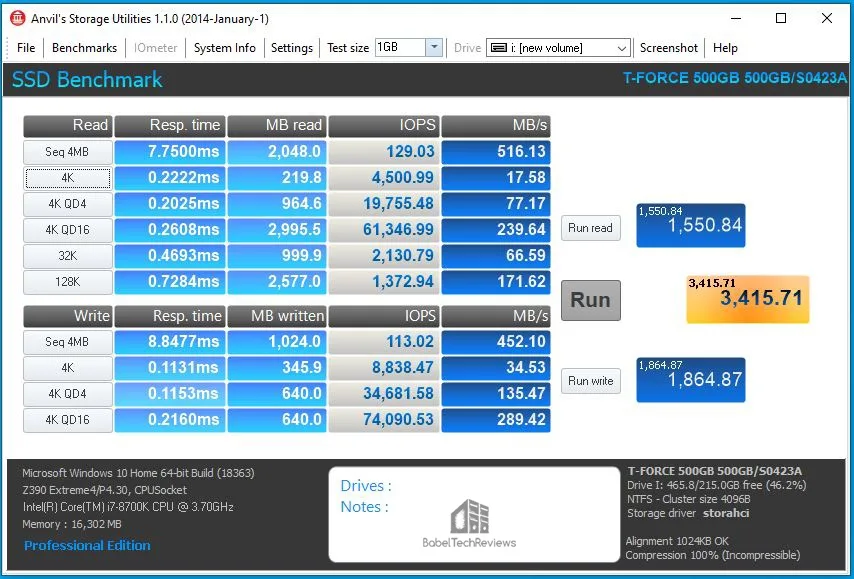
Surprisingly, the Team Group L5 LTE SATA III SSD scores higher than the Vulcan SSD.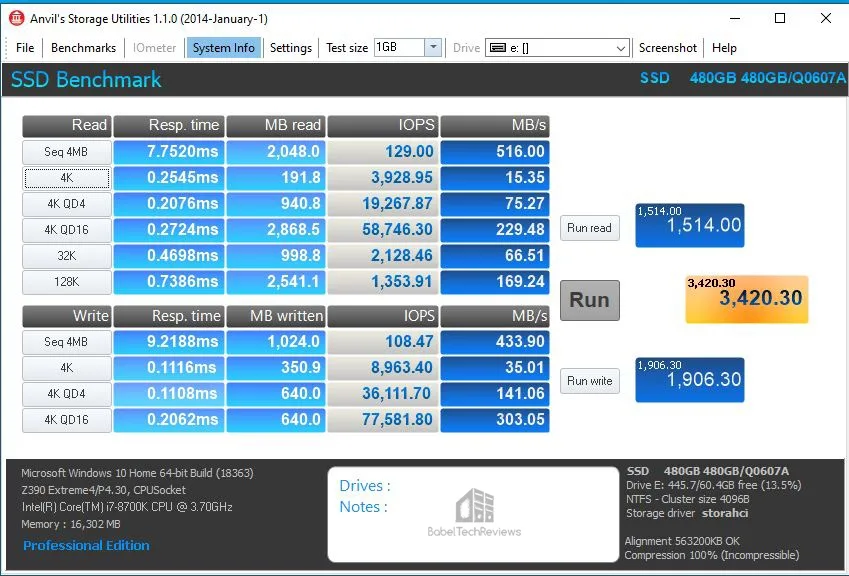
Team Group PD400 portable SSD is the slowest SSD.
We didn’t benchmark the Seagate FireCuda 2TB SSHD. Here is the Anvil’s Storage Utilities summary. Higher scores denote faster drives.
Let’s check out what is probably the most popular benchmark for benching SSDs and HDDs, CrystalDiskMark.
CrystalDiskMark 7.0.0
CrystalDiskMark is a HDD benchmark utility for your drives that measure sequential and random read/write speeds. Here are some key features of “CrystalDiskMark”:
- Measure sequential reads/writes speed
- Measure random 512KB, 4KB, 4KB (Queue Depth=32) reads/writes speed
Here are the PD1000 portable SSD results: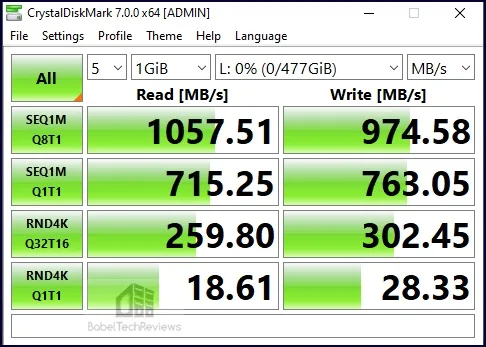
Here is the summary chart highlighting the most often quoted Read/Write performance data. Higher is better.
The NVMe2 drives are the highest performing drives; the Liquid CARDEA is the fastest drive followed by the MP33 and the Kingston A1000. The PD1000 is still faster than the SATA III drives represented by the T-FORCE Vulcan, Delta Max, and Team Group L5 LTE SSDs. The Team Group external PD400 is the slowest SSD but it is much faster than the FireCuda 2TB SSHD.
Let’s look at our next synthetic test, HD Tune. This free standalone synthetic test is old and it doesn’t represent real world performance but it does test some important drive metrics. There is also a pay-for HD Tune Pro which is up-to-date and offers more functionality. We tried the Pro trial recently just to make sure the free version is still relevant.
HD Tune
HD Tune has the following functions, and it measures the performance of:
- Transfer Rate
- Access Time
- CPU Usage
- Burst Rate
- Random Access test
- Write benchmark
Hard Disk information includes partition information, supported features, firmware version, serial number, disk capacity, buffer size, transfer mode.
- Hard Disk Health
- S.M.A.R.T. Information (Self-Monitoring Analysis and Reporting Technology)
- Power On Time
- Error scan
- Temperature display
Here are the PD1000 HD Tune benchmark results: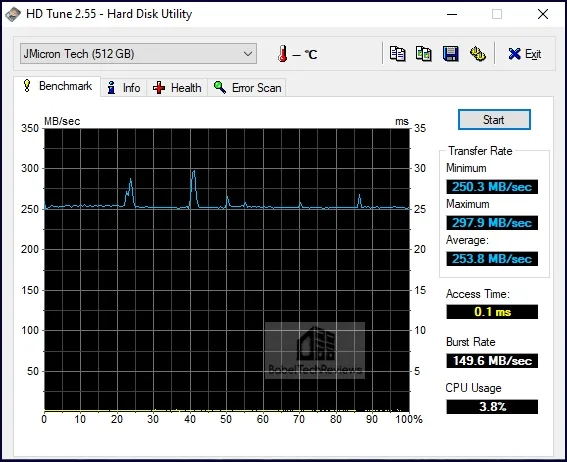
Here are the HD Tune benches summarized in a chart.
There are no surprises. The PD1000 is slower than the internal PCIe NVMe2 drives, but it is faster than the SATA III drives. The PD400 is competitive with the other internal SATA III SSDs.
Next we benchmark using AS SSD.
AS SSD
AS SSD is designed for Solid State Drives (SSD). This tool contains synthetic and practice tests. The synthetic tests determine the sequential and random read and write performance of the SSD without using operating system caches. In Seq-test the program measures how long it takes to read and write a 1GB file.
In the 4K test, read and write performance for random 4K blocks are determined. The 4K-64-thrd test are similar to the 4K procedure except that the read and write operations on 64 threads are distributed as in the usual start of a program. For the copy test, two large ISO file folders are created, programs with many small files, and a games folder with small and large files. These three folders are copied by the OS copy command with the cache turned on. AS SSD gives an overall score after it runs the benchmarks.
Here are the PD1000 SSD AS SSD results.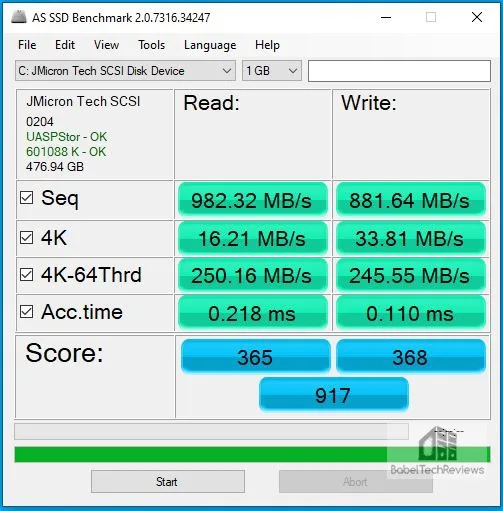
Here is the summary.
The SSHD or HDD tests appear to take forever with AS SSD and they score very low compared with any SSD. Again, the USB 3.2 PD1000 competes very well with the SATA III drives. Next up, ATTO.
ATTO
ATTO is a low level hardware benchmark for random access read/write storage devices including for SSDs and HDDs. HD Tach uses custom device drivers and low level Windows interfaces to determine the physical performance of the device.
Here is the ATTO PD1000 SSD results.
The Kingston A1000 NVMe2 SSD results follow.
Team Group’a MP33 NVMe2 SSD results are next.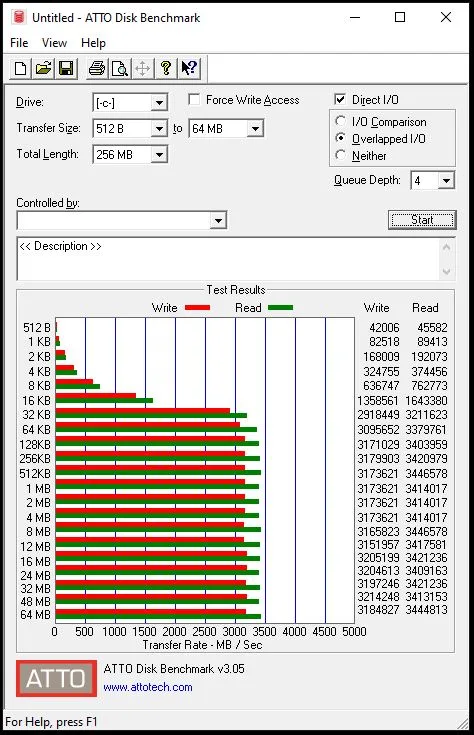
Here are the Liquid CARDEA NVMe2 SSD ATTO results.
The T-FORCE Vulcan SATA III SSD results are next.
Here are the T-FORCE DELTA MAX SATA III SSD ATTO results.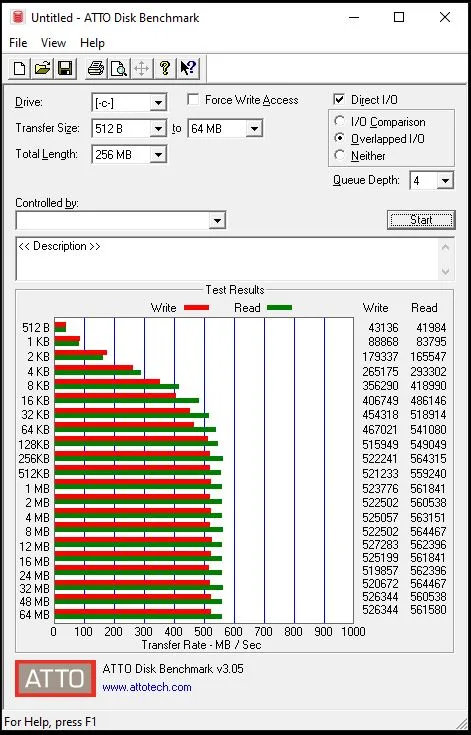
The Team Group L5 LTE 3D SATA III SSD results are next.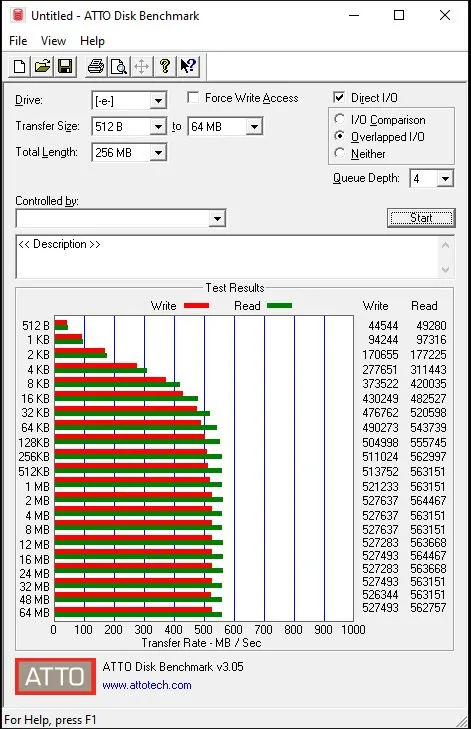
Here are the Team Group PD400 portable SSD ATTO results.
Finally, the FireCuda 2 TB SSHD’s ATTO benchmark results:
Again we see very solid results from the PD1000 putting it into contention with the internal SATA III SSDs.
HD Tach is up next.
HD Tach
HD Tach is a low level hardware benchmark for random access read/write storage devices. HD Tach uses custom device drivers and low level Windows interfaces to determine the physical performance of the device. It is no longer supported and needs to be run in compatibility mode for Windows 10.
Here are the Team Group PD1000 SSD HD Tach results with an average read of 268.2 MB/s.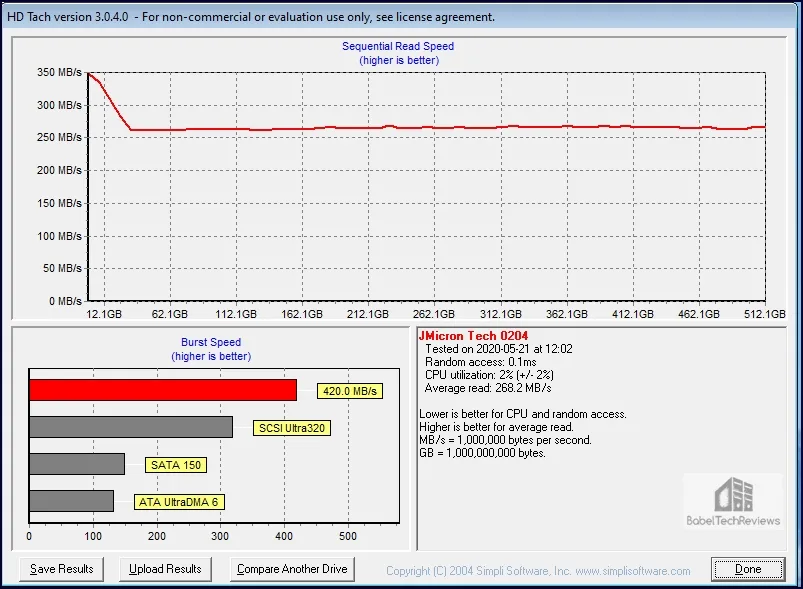
Here are the HD Tach Disk benches summarized in a chart comparing our nine drives. For read speeds, higher is better but for access times, lower is better.
As usual, the PD1000 and the NVMe SSDs are ahead of the other SATA III SSDs while the SSHD sits in last place.
We can sum up all of our synthetic benchmarks by stating that the Liquid CARDEA is the fastest PCIe NVMe2 drive followed by the MP33 and then by the A1000 SSD. The PD1000 is generally faster than SATA III drives represented in descending order of performance by the T-FORCE Vulcan, DELTA MAX, and Team Group L5 LTE 3D SSDs. The entry-level Team Group USB 3.2 PD400 is the slowest SSD but it is still much faster than the FireCuda 2TB SSHD which is always in distant last place.
File copy speeds are important to most gamers especially when they want to quickly transfer their game files from one location to another.
File Copying
The PD1000 is the fastest SSD that we have tested by copying a 22.6GB Steam folder from program files to the desktop.  The PD1000 only took 45 seconds to copy 22.6GB from desktop to program files.
The PD1000 only took 45 seconds to copy 22.6GB from desktop to program files.
The Liquid CARDEA, which is a generally faster NVMe2 SSD, took 105 seconds for the same copy.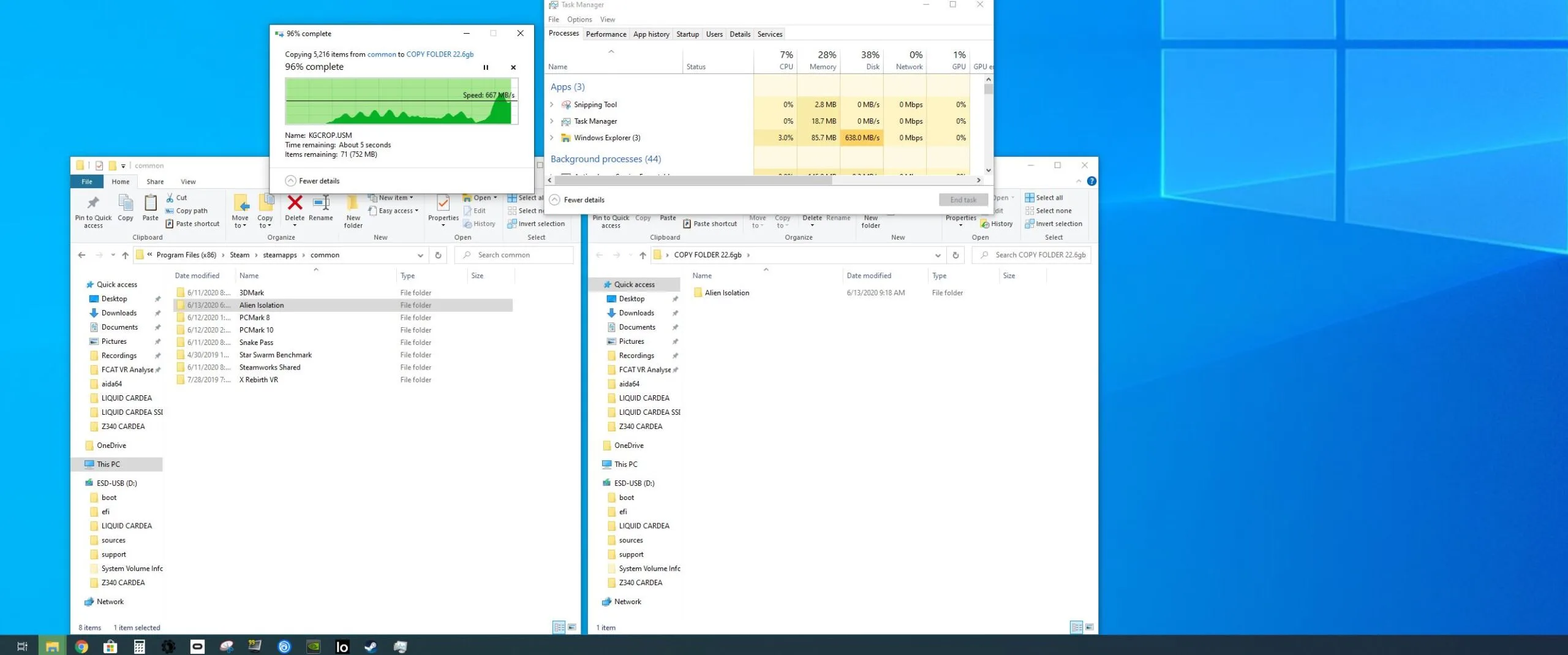
The Team Group MP33 M.2 PCIe 1TB SSD is more inconsistent in its speeds for large files. It took about 165 seconds to copy the same 22.6GB Steam folder from program files to the desktop, but almost 10GB of the total was copied in less than 20 seconds after a slow start.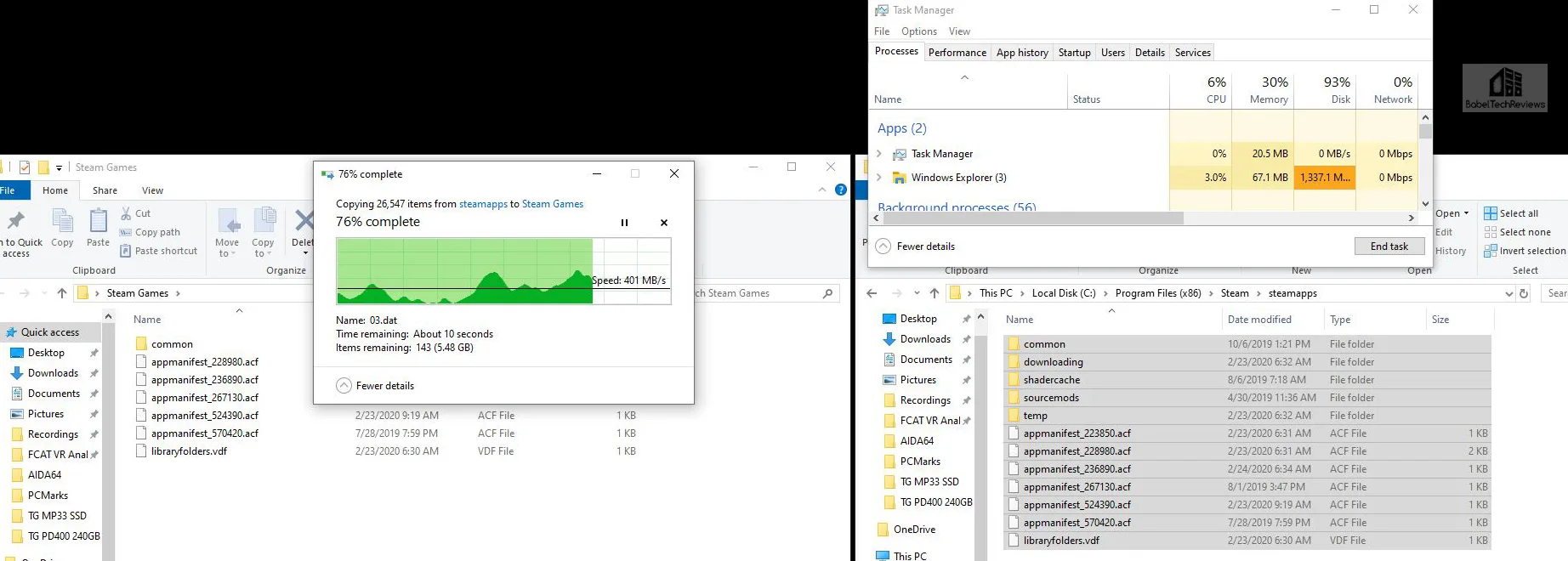
If you do a lot of file copying, then you might want to consider a PD1000 portable SSD.
Let’s look at game and game level loading times again.
The Game/Level Loading Time Results
Game and game level loading time results are very difficult to measure precisely but it is easy to see that generally SSDs perform similarly with regard to game loading times and they are miles ahead of any HDD. Even SSHDs require loading the same level or program over-and-over to get quicker.
Here are the World of Warcraft and Battlefield 3 loading times again as measured precisely by PCMark 8’s storage test. Lower (faster setup in seconds) is better.
All of the SSDs load games quickly and there is very little difference between them. The PD1000 loads the two test games within two seconds of the fastest NVMe2 SSD, in sharp contrast to loading from a SSHD or HDD.
As far as playing games from the external USB 3.2 Gen 2 PD1000, we could not tell any difference whatsoever in either performance or in game/level loading times. Until developers start to target SSDs for game storage, or perhaps after the next generation of consoles move away from hard disk drives, we may see SSDs achieve the game loading performance they are capable of. For now, there is no disadvantage to using a PD1000 external USB 3.2 Gen 2 SSD over an internal SSD as an operating system primary drive or to launch and play games from.
Here are all of the Summary Charts again for easy reference.
Non-Gaming Summary Charts
In almost all cases, the Team Group PD1000 external USB 3.2 Gen 2 drive is faster than the SATA III based SSDs.






 Those who want to have the very fastest PCs, will prefer an internal PCIe NVMe SSD. But for gaming and for regular tasks, any SSD will provide similar performance. We would recommend upgrading from a HDD or from a SSHD to any SSD including using a USB 3.2-based SSD which will make loading and reloading games and levels a lot quicker than loading from a SSHD or HDD. The Team Group PD1000 SSD is a great choice for gamers.
Those who want to have the very fastest PCs, will prefer an internal PCIe NVMe SSD. But for gaming and for regular tasks, any SSD will provide similar performance. We would recommend upgrading from a HDD or from a SSHD to any SSD including using a USB 3.2-based SSD which will make loading and reloading games and levels a lot quicker than loading from a SSHD or HDD. The Team Group PD1000 SSD is a great choice for gamers.
Let’s head for our conclusion.
The Conclusion & Verdict
The technology is still improving and it seems that SSD pricing remains reasonable although it appears to be going up. SSD technology has become much more accessible, and it appears that gamers need more capacity than 250GB drives provide as games are getting quite large. We would suggest that 500GB is the minimum capacity for a gamer, and 1TB is better as a primary drive.
If a gamer wants to keep some games on a external SSD, it appears that a 240GB PD400 is probably sufficient for two to four AAA games. Besides being used for an OS drive, the 512GB PD1000 could be useful for bringing games over to a friend’s house, or for storing extra games that can be easily launched and played over USB. It may also serve as an XBox drive.
It is not mandatory to have a SSD if you use your PC only for gaming and have a lot of patience. Games do not perform better on SSDs as developers still target HDDs for optimizing game performance. But games often take significantly longer to load from a HDD or SSHD than they do from any internal or external SSD. If a gamer wants to get right back into the game, a PD1000 will improve immersion and decrease frustration.
Windows 10 is becoming more and more painful to use when installed on a mechanical or even on a hybrid solid state/hard disk drive. Indexing, Search, or Anti-malware Windows programs may often saturate the bandwidth of a mechanical drive, and even downloading or updating Steam games may slow your PC to an irritating crawl. This will not happen using a PD1000 external USB 3.2 Gen 2 SSD.
Pros
- The portable Team Group PD1000 USB 3.2 Gen 2 512GB SSD is significantly faster than any mechanical hard drive or SSHD and it’s generally faster than internal SATA III SSDs
- The PD1000 is convenient, small, shockproof, dustproof, waterproof, light, and it transports easily
- 3-year warranty backed by Team Group support
- Fast game/level loading speeds similar to internal SATA III and PCIe NVMe2 SSDs
- Good fast inexpensive external storage suitable for gaming or as a primary OS drive
Cons
- None
This has been an enjoyable exploration comparing eight drives with the Team Group PD1000 512GB external USB 3.2 Gen 2 SSD. The performance of this external drive is suitable for quick transfer of data or for storing, playing, and launching games, and it meets or exceeds Team Group’s specifications for it.
The Verdict
 We feel that the Team Group portable PD1000 deserves BTR’s “Highly Recommended” Award as a very fast external USB 3.2 Gen 2 SSD. The PD1000 over USB 3.2 is generally faster than any SATA III SSD. We also think it is a good deal at $79.99 shipped from Newegg. The 1TB version is $145.99 for those who need a higher capacity drive.
We feel that the Team Group portable PD1000 deserves BTR’s “Highly Recommended” Award as a very fast external USB 3.2 Gen 2 SSD. The PD1000 over USB 3.2 is generally faster than any SATA III SSD. We also think it is a good deal at $79.99 shipped from Newegg. The 1TB version is $145.99 for those who need a higher capacity drive.
As a portable fast external USB 3.2 Gen 2 SSD, the PD1000 is a great way to store, launch, and play games especially for notebook gamers, or even in a desktop situation where the internal SATA connections are in use. It is suitable for using as a operating system drive, and we could not tell any difference with gaming performance even after comparing it directly with the Liquid CARDEA NVMe2 SSD.
SSD prices change daily so we suggest checking for sales to get the best bang for buck. We recommend the Team Group PD1000 USB 3.2 Gen 2 SSD as an great choice for a gamer who wants a portable fast external drive with a 3-year warranty.
Next up, we are heading back into VR for a game review.
Happy Gaming!

